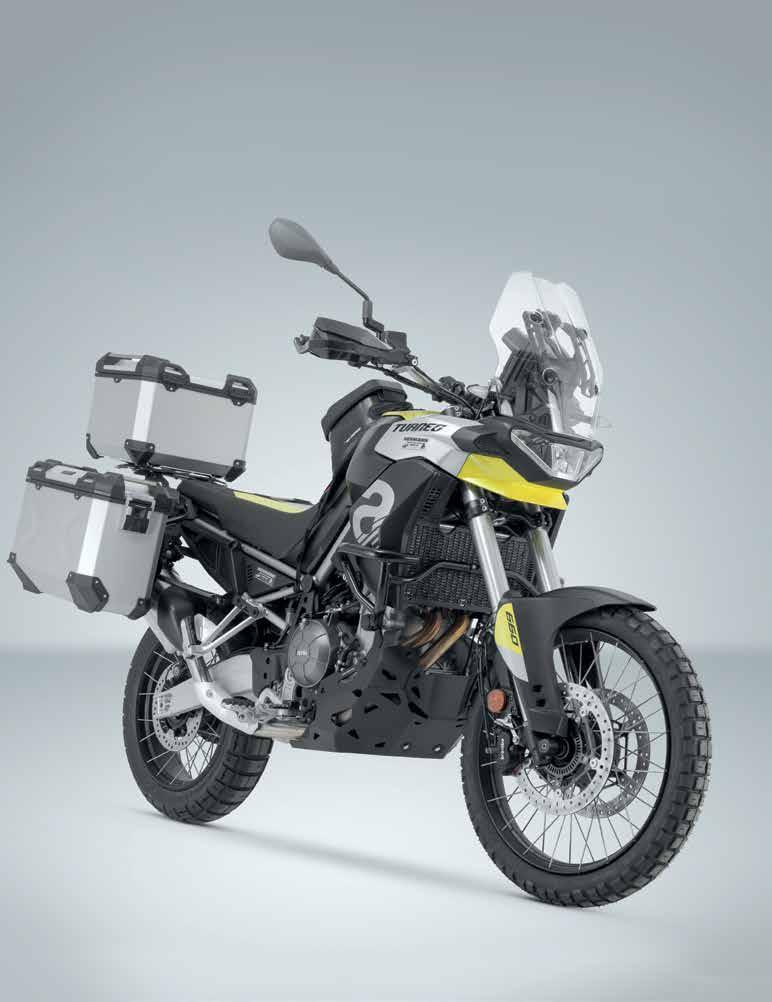
It’s


It’s
Electronics are clearly going to play a huge part in the future of adventure riding.
There’s the looming move to outlaw the internal-combustion engine for starters. It’s a little way off, but I believe it’s definitely coming.
I expect there’ll still be enthusiasts who form clubs and have special dispensation to run internal-combustion engines at accredited club meetings. They’ll be small groups of grey-bearded ol’ diggers at
school fetes and charity events, and they’ll start up their bikes to the ‘ooo’ and ‘aah’ of amazed onlookers who have their hands over their ears and their noses wrinkling at the unsavoury, unhealthy emissions.
I don’t expect there’ll be a lot of scope to organise long-distance rides to far-flung and little-known locations, but those places probably won’t have petroleumbased fuels available anyway. They’ll have charging stations, most likely powered by wind and solar installations.
I won’t be around to see that extreme, but there’s no doubt in my mind future generations will be groomed to view the use of internal-combustion engines with about the same level of approval that smoking cigarettes in maternity-ward waiting rooms is viewed today.
Maybe that’s not a bad thing. Nobody seemed to care about tobacco use when I was a kid and we’re undeniably better off now.

Electric vehicles are gaining acceptance fast. A couple of the European websites I visit regularly have already introduced the term ‘thermals’ to refer to bikes with internal-combustion engines, and have adopted the posture of them being a drab representation of times past. ‘EM’ – electric motion – is the catchcry for youth, health and an exciting future. I’m well past worrying about my youth, my health is fairly good, and excitement at the bikes I still hope to ride and the places I still hope to see continues undiminished. But even though I don’t expect I’ll live to see the end of siphon hoses, big fuel tanks and air filters, electronics are steadily increasing their influence over our relationships with our bikes. Riding modes, electronically controlled
“ There’s the looming move to outlaw the internalcombustion engine. ”
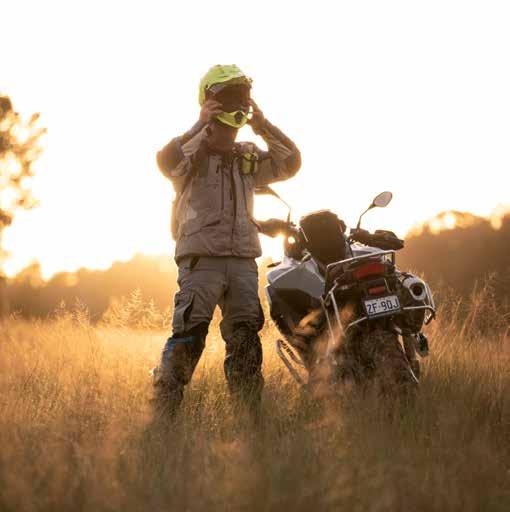
suspension and multiple, selectable ignition maps are obvious examples, but even at a more basic level, systems like fuel injection and ABS have put maintenance and trailside repair largely out of reach for owners.
I suspect those are things future generations will take for granted. Just as my generation absorbed ‘fuel, spark and compression’, along with reciting our multiplication tables and learning the national anthem in our very early childhood, youngsters yet to be born will, at their mothers’ breasts, be coached in Ohm’s law, ‘current in = current out’, and being without a smart phone will, for them, be like me losing my key and my wallet at the same time.
It’s all going to change, whether we like it or not.
What should we mad-keen riders do about that situation now?
Go riding. Often. For as long and as far as you can.
We’re the lucky ones, living in a time when the rider can have such a huge personal bond with a bike and the people we ride with. Let’s make the most of it.

Adventure
Publisher Kurt
Editor Tom
tom@maynemedia.com.au
Group Sales Manager
Mitch Newell
mitch@maynemedia.com.au
Phone: (02) 9452 4517
Mobile: 0402 202 870
Production
Arianna Lucini
arianna@maynemedia.com.au
Design
Danny Bourke
art@maynemedia.com.au
Subscriptions
1300 76 4688
arlette@maynemedia.com.au
ISSN

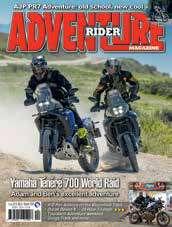



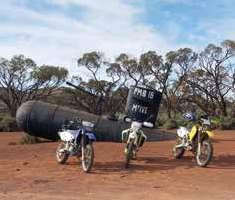
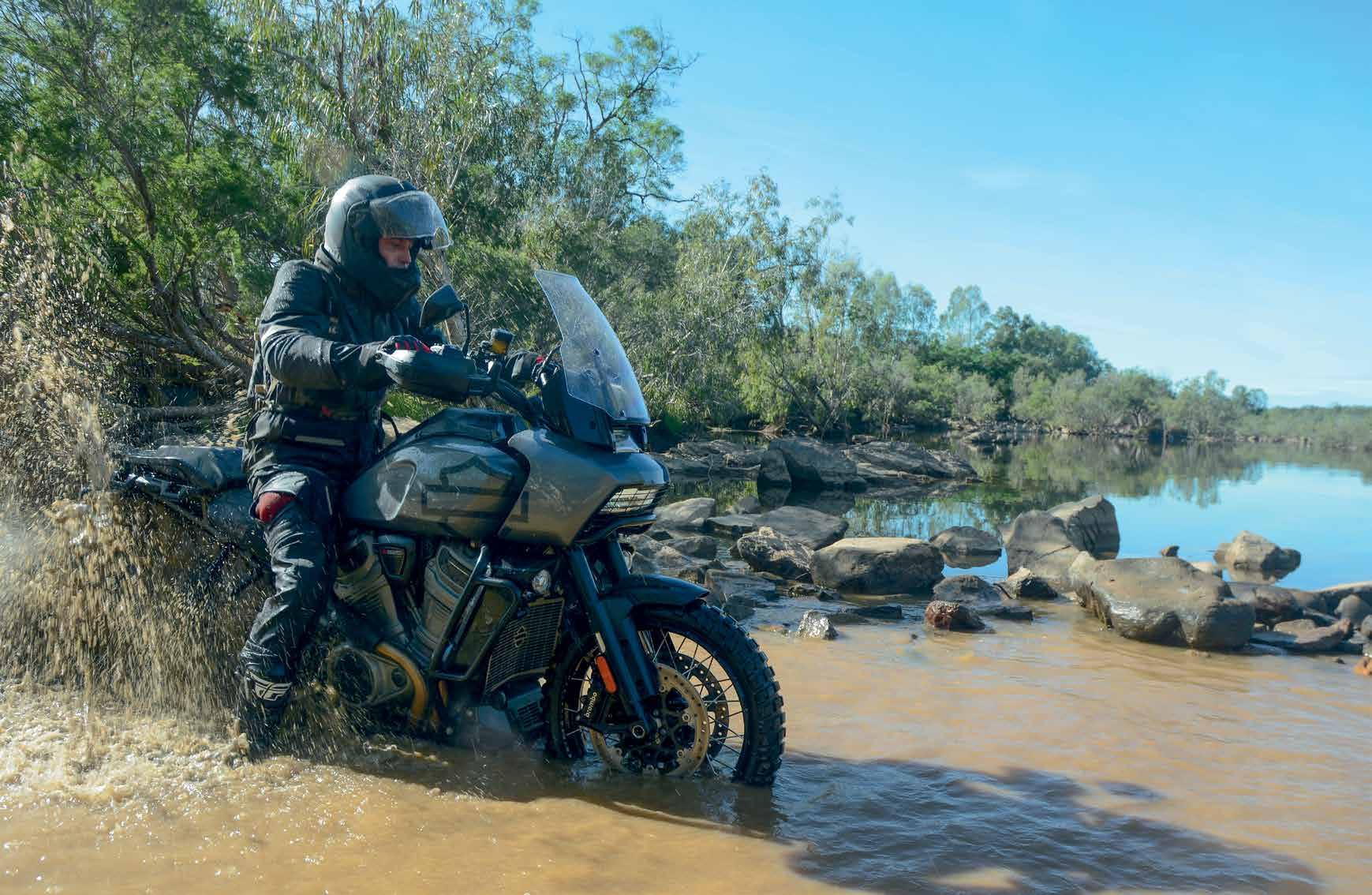
Harley-Davidson was keen to highlight the adventure credentials of the Pan America. A blast through far north Queensland’s notorious deep-water crossings, rocks, loose sand and tropical rainforests seemed like a good start. u

The only way to get really wild on a bike north of Cairns, but to ensure all permits, insurances and local sensibilities are properly covered, is to tag up with Cape York Motorcycle Adventures. So on a warm, overcast morning, a line of bright, shiny Pan Americas awaited the attention of some
very eager riders at CYMCA headquarters – some of whom weren’t so quite so bright and shiny as the bikes.
Harley’s commitment to the project was highlighted by the inclusion of HarleyDavidson ANZ Managing Director Nigel

Keough, who well and truly dived in at the deep end. It was Nigel’s first adventure ride, and he appeared gifted with all the welcoming polish and quiet competence of the bikes themselves.
Also on guest list were a few old timers, people like Adventure Rider Magazine’s editor and, it has to be
u
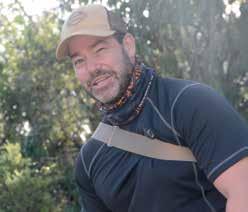

said, CYMCA’s top man, Roy Kunda. Roy and TF had a wealth of war stories from rides of decades past which soon had the younger ones yawning and working busily on their phones. Also in the more senior – and sensible –section of the group were riders like long-time dirtbike legend and Harley dealership owner Wayne Leonard, Gav Hume and Jason Cochrane from the Harley Owners Group, and journo Phil Suriano.
The younger – and considerably sharper-looking – segment of the crew was made up of Harley dealer principal Brent Story, bike journo Dylan Ruddy, Channel 7 Sunrise weatherman James Tobin and H-D ambassador and ex-Nitro Circus rider, Emma McFerran. Nigel and V8 Supercar driver Craig Lowndes seemed to easily bridge the generation gap, and Harley staff included supertech Dan Lesnock and Customer Experience Manager Ben Foster.
Top: FNQ, eh? Even the bitumen sections are amazing.
Right: Harley-Davidson Customer Experience Manager Ben Foster.
Far right: The always calm, always smiling Harley tech, Dan Lesnock. Below: Rain meant Black Mountain Road was treated with respect.

CYMCA support included Roy’s son Jordan – Jordy – and Craig ‘Tucks’ Tucker, who drove the support truck and offered the kind of catering which is a hallmark of every CYMCA ride. It was a diverse group in lots of ways, but the love of riding and a desire to see whether the Pan America was for reals was common to all.

The first challenge was thrown down almost immediately. The rain began to fall as the entourage rolled out of CYMCA headquarters. It wasn’t the kind of thundering downpour which can raise the level of a north-Queensland creek several metres in a couple of hours, but it

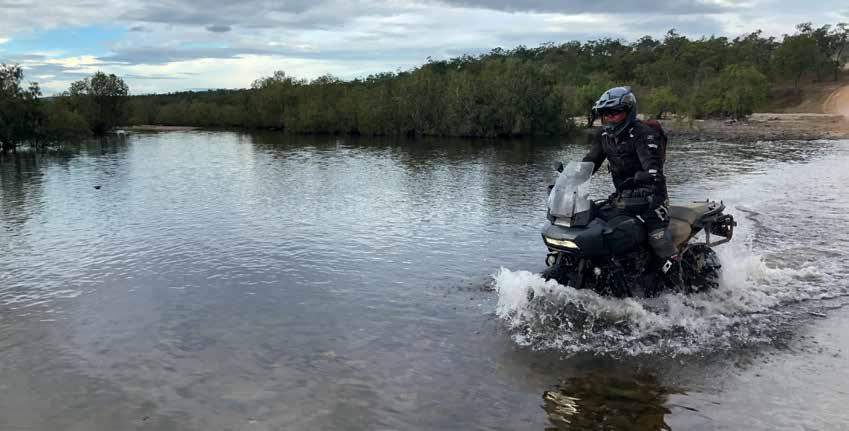
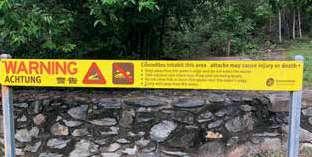
was enough to make sure Black Mountain Road and the run to Mount Molloy were treated with respect. Riders settled in and began working with the Pan America’s different modes and personalised settings to find their happy place in the prevailing conditions. It became obvious straight away the group consisted of some spectacularly wild and carefree riders – the young ones and Lowndsey – and some overly cautious and grumpy punters who kept wanting to pull up and say things like, “What does it mean when an orange picture of a brake stays on?” And, “I once rode through here on a KDX.”
Even with all the differences in riding styles and philosophies, the Pan America still managed to please everyone, and that was no small achievement.
Fobbed off
As the sun broke through at the Mount
Molloy pub, and one passing truck playfully hooked up on the rear of another reversing from a parking spot and tore away large sections of bodywork, one of the camera guys emerged from lunch to find his DR-Z camera bike had a flat tyre. Before anyone could say, “Geez. I hope someone here will fix that,” Jordy had thrown the thing up against a tree, wrenched the rear wheel out, effected a repair and had the whole show ready to run again.
Above: Jason Cochrane handled the Palmer River crossing better than some. Above insert: Achtung! Das snappy-jawed schweinhunds!
Unfortunately, in his effort to keep things flowing in the time-honoured CYMCA manner, Jordy had sent the other rider ahead on Jordy’s own Pan America. In a trap for young players, when the pair swapped back the other rider had the fob for the Pan America’s keyless ignition in his pocket. He’d disappeared into the dust before Jordy tried to start his bike and realised the situation.
But these things happen, and with a little toing and froing, and perhaps a red face or two, it was soon sorted out. At least Jordy had plenty of time to enjoy the view from the lookout.
Down and under
Below left: Dan Lesnock earned a big cheer when he flexed his muscles after recovering his bike from the depths of the Palmer River. Below right: Adventure Rider Magazine’s editor was a big fan of the Pan America before this ride. He’s an even bigger fan now. u

As the day progressed bikes and riders were confronted with fast-running causeways, a great deal of dust, some very long straight stretches of dirt road, incredibly beautiful rainforest sections and, in Craig Lowndes’ case, the


attention of very enthusiastic fans at fuel stops.
Camp for the night was on the edge of the Palmer River, and that meant crossing the river itself. The slippery, rocky riverbed had the big bikes jolting and shimmying around, and even though a couple went under, the crossings were accomplished with a great deal of friendly pushing and yahooing and a minimum of fuss. When the video crew requested some riders repeat the crossing for the cameras, Harley tech Dan Lesnock won the admiration of all by adopting the attack position, barrelling into the rocky crossing with great enthusiasm and coming unstuck in a particularly deep and slimy section. His muscle flexing as he emerged from the depths earned cheers from onlookers, as did the bike when it fired up without hesitation and completed the crossing.
Full service
Camp that night was a CYMCA special.
The big Isuzu support truck sat solid on the clean white sand and supplied light, music and a cavalcade of luxuries: cold
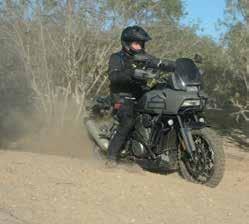

drinks, hot drinks, a big variety of salads and, as the sun set, tender steaks cooked to perfection over the open fire. Riders who’d soaked in the gently flowing Palmer in the late afternoon discussed the bikes and the day’s riding, and the general disbelief there was still a place in world without no phone or internet reception. That situation led to a few stories being shared and a few cold drinks consumed until, with the river murmuring away in the background, all bunked down to prepare for the following day.
Leaving the Palmer River campsite proved a little more involved than the arrival, with the short section of deep sand proving a test for those not used to that type of terrain. Once again the riders banded together to ensure all were clear and on
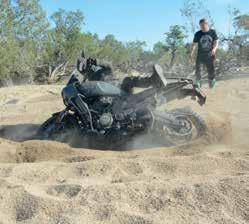
their way to the old gold-mining town of Maytown to soak up a little history. By that stage the sun was beating down with true tropical force, and heat and humidity, as opposed to the rain and cooler temperatures of the previous day, became potential problems which needed careful management. The Pan Americas were excellent in that situation. The big bikes were rock steady and easy to keep moving at a brisk pace over the seriously long, hot and dusty sections which followed.
The tiny town of Laura was the lunch stop and riders woofed into barra burgers while Nigel Keough showed his incredible personnel-management skill, which had no doubt played a major part in his success in a multinational corporation, by handing out icy poles to the parched and dusty riders.
Adventure Rider Magazine’s editor was totally blissed out by the Bubble O’Bill he received on that occasion.
As Lowndsey politely and cheerfully deflected the attentions of yet more fans, posing for numerous selfies and then
Above left & right: Ex-Nitro Circus rider and Harley ambassador Emma McFerran made a silky-smooth exit from the beach. Below: No holds barred! The Pan Ams didn’t get any special treatment. u

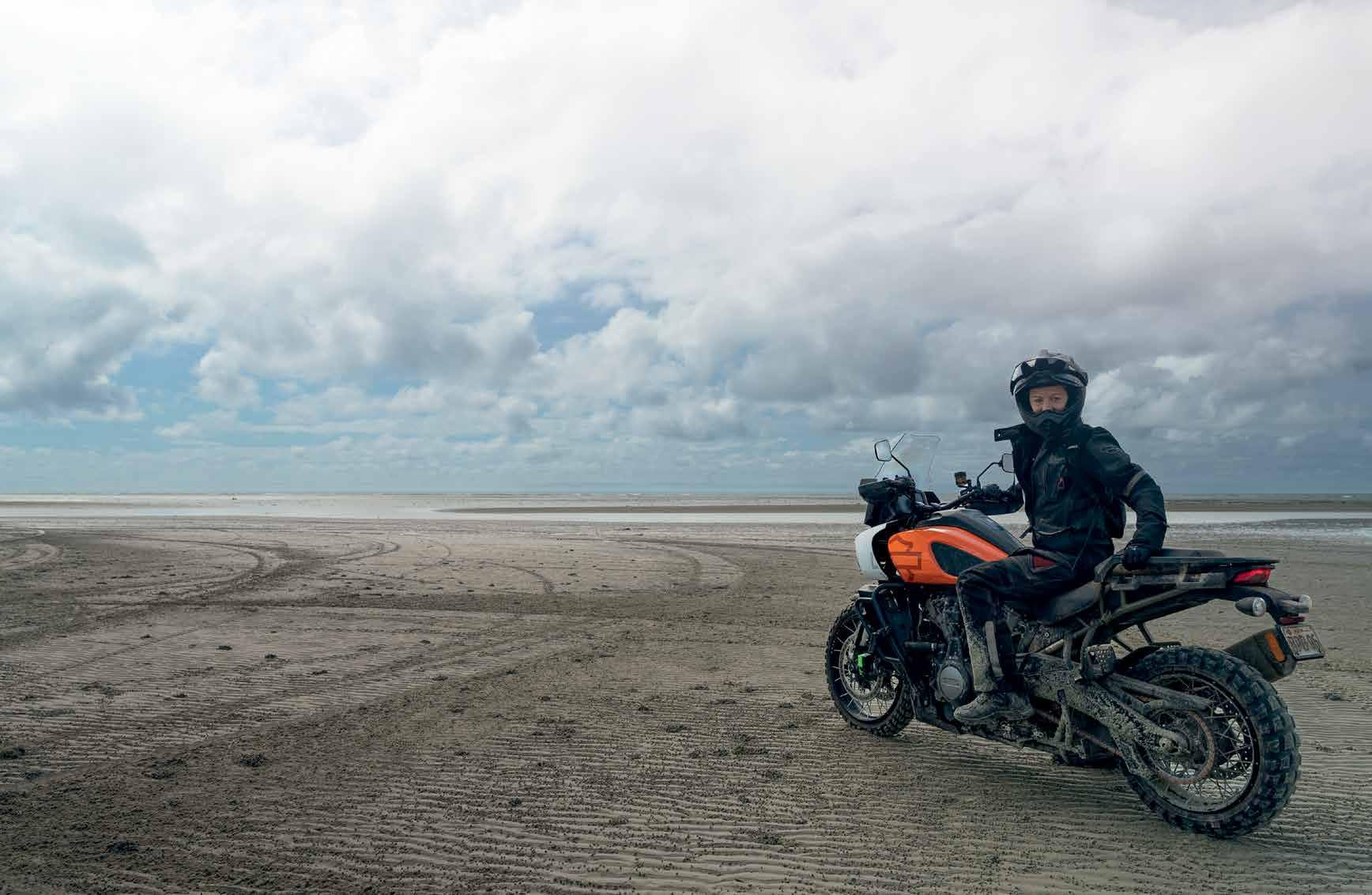

beating a retreat with his customary good will and winning smile, it was decided to bolt for the Lion’s Den, just a short ride further on and an overnight stop which had everyone beaming with anticipation.
As the bikes rolled into what must surely be one of north Queensland’s quirkiest and most memorable landmarks, dusty, stained riding gear was swapped for swimmers, cold drinks were grabbed, and most riders stampeded their way down to the croc-free swimming hole behind the Lion’s Den. Tucks had the support truck at DEFCON 5 and the cold drinks and luggage were dispensed at lightning speed as the stampede moved from the swimming hole to the hot showers. Night fell, the live music kicked off, and large pizzas and steak meals flowed from the Lion’s Den kitchen into the party atmosphere of the beer garden.
Oh yes. It was a big night that one, with many a bold and exaggerated tale bellowed across the garlic bread and calamari rings.
The late TF
The final day was a short one to ensure

his way around the fleet to make sure everything was in good shape.
On an interesting side note, Craig Lowndes discovered on the first day the bikes were limited to 179kph. It was done to match the speed rating of the tyres, but it does make one wonder how Craig discovered that.
everyone could make return flights, but it was also a highlight which included the Bloomfield Track.
Things got off to great start when the publican of the Lion’s Den casually mentioned he’d love a ride on a Pan America. The Harley folks nodded their approval, so Roy Kunda, a frequent visitor to The Den, said the publican should suit up in Roy’s gear, which was in his donga, and go for short blat.
Roy continued casting an eye over bikes, riders and equipment to ensure all was ready for the day while the publican went to the wrong donga, suited up in Dylan Ruddy’s kit, and was nothing more than heat haze on the horizon when Dylan appeared wiping breakfast crumbs off his chin and asked, “WTF?”
A few bits and pieces had worked loose on a couple of the bikes and riders had settled in to where they had specific tunings they wanted, so Dan worked
With Dylan back in his permanently red-stained riding gear and breakfast dealt with, the cavalcade set out on the final leg.
There was an opportunity for some lunatic time on a beach which everyone enjoyed. Well…pretty much everyone. Adventure Rider Magazine’s editor distinguished himself by spearing arse-up into the soft sand leaving the beach, and then standing around with a camera to see if it would happen to anyone else. There were a few candidates, but when Emma McFerran made the exit look so damn stylish and smooth he dug his goggles out of the dune, spat out the remains of the sand and left in a huff.
Lunch at a swisho eatery in The Daintree was a colourful affair with reggae music, dreadlocks galore and a short power outage, followed by a glorious run along the coastline back into Cairns.

As a final escalation to the level of adventure, Adventure Rider Magazine’s editor somehow managed to get himself lost on the way into Cairns. He rode around in ever increasing circles until finally rolling in to CYMCA head office with all of about 10 minutes up his sleeve to make his flight. Jordy supervised a fast change of apparel and bundled TF into a waiting van, only to find the flight delayed by an hour.
Lifestyle and freedom have always been Harley-Davidson catchcries and this ride, while it definitely put the Pan America through some serious, real-world adventure challenges, gave the riders the chance to embrace those ideals and experience the decades-old Harley culture
in a fresh and contemporary setting.
Across the three days the bikes were hammered, dropped, dragged, bogged and submerged until there was nowhere left to hide, and they still came up trumps.
Some bits and pieces vibrated off here and there, a couple of punctures slowed things up, and a few rear tyres finished up in poor condition.
But that happens on any adventure ride with 16 bikes.
As for the people, they were the best. What started out as a friendly group with a common interest finished up with a bond forged in mutual respect and the need to look out for each other.
And the catalyst for the whole thing was Harley-Davidson and the Pan America. Lifestyle and freedom at its best, for sure.
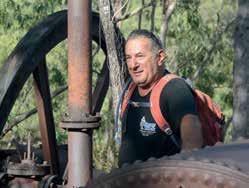
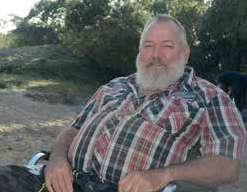

In an amazing demonstration of off-road capability, Triumph’s all-new Tiger 1200 Rally Pro completed the 2022 SA 24 Hour Trial. The race is a huge challenge for both bike and rider under any circumstances, and it was a herculean achievement for one of Australia’s most successful, likeable and irrepressibly cheerful competitors, Cam Donald. Cam took some time to chat about the race with Adventure Rider Magazine.
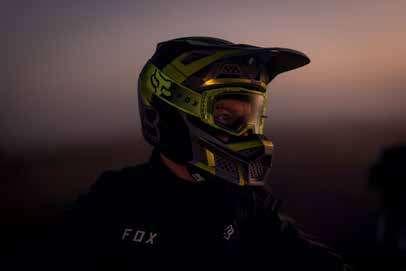
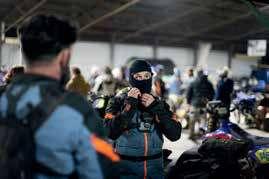
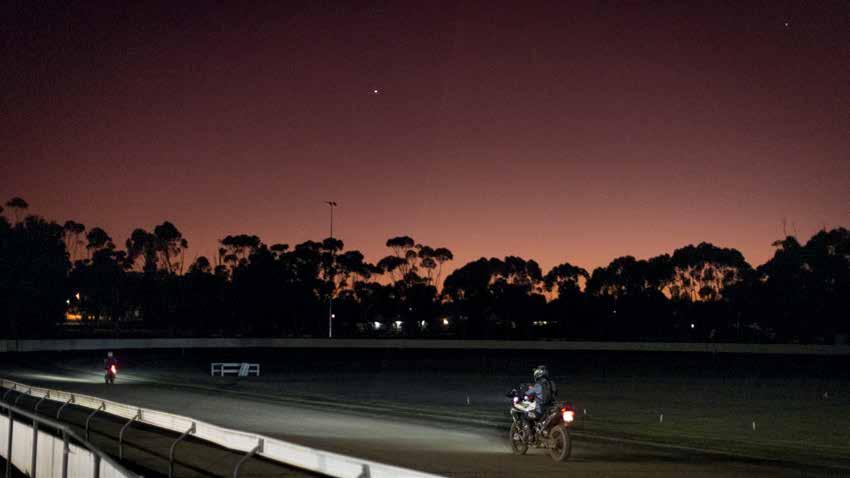
The SA 24-Hour Trial, historically known as the 24-Hour Reliability Trial, has been running since 1924 and is Australia’s oldest motorcycle race. It’s made up of four six-hour laps, with each lap including 12 competitive timed sections and 13 transit legs. Three fuel stops allow 15 minutes at each for maintenance, but outside assistance isn’t permitted.
It’s a tough event. In 2022 138 started and 91 finished. The duration is daunting enough, but to tackle it on a 1200cc adventure bike raises the level of difficulty to a forbidding level.
Above: The duration alone makes the SA 24 Hour Trial a huge challenge for both bike and rider. Above insert: Sub-zero temperatures for around eight hours made for brutal conditions. Below: Cam’s experience allowed him to ride at the right level – not too hard, but not too slow.
Two-time Isle of Man TT winner, international road racer and avid off-road rider and racer Cam Donald and his lifelong friend Donald Owen, an expert-level off-road competitor, fronted the start line on Triumph-supported Tiger 1200s to see how they’d go.
After a good start and settling in to a
steady rhythm, Donnie’s 2022 ride came to an end at the 16-hour mark.
But Cam was able to hold his pace and claim a glorious finish.
it
At 44, Cam has a wealth of experience to draw on, including a class win at this same event in 2018. That victory was on a Gas Gas 250cc two-stroke, a far cry from the big Triumph. There were a few aces up Cam’s sleeves, but there were a few jokers thrown his way as well.
“It was dry, and I was blessed. I don’t know how we would’ve coped if it
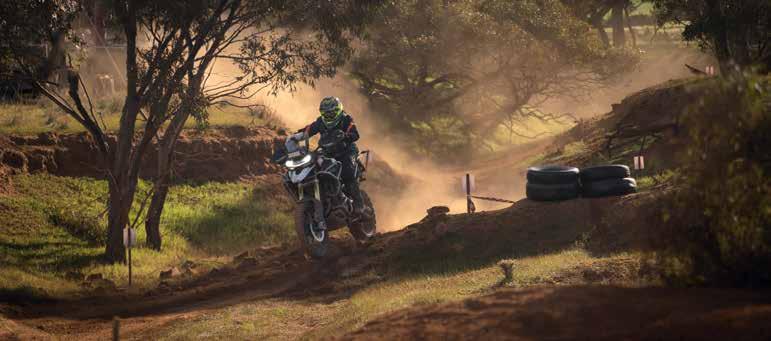
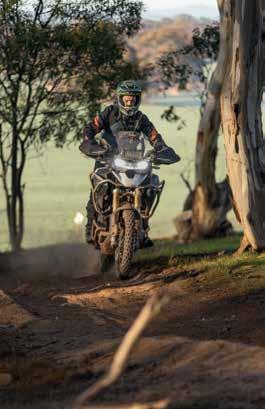
was wet,” said the tired racer from Warrandyte in Victoria.
“At the end of the day, grip levels, especially on the rear, were very, very low. I ran a Pirelli Scorpion Rally which looked like a full-blown knobby on the front, and it was good. There’s a shortage of adventure tyres at the moment, and on the rear I ran the Motoz RallZ because it was the best tyre I could find.
“A lot of the course was foot-deep bulldust. If it’d rained, I can only imagine how that would’ve chopped up. But there was some mud, and the
rear tyre really didn’t grip the wet clay. That turned into pretty hard work in the slippery sections.”
Adding to the difficulty of running a big bike in an off-road endurance event of this calibre was the course for the 2022 event, the most physical in the race’s history. But, according to Cam, the Triumph pulled its weight.
“I knew getting the bike through was going to be a big task,” he explained, “because a lot of the special tests were very technical. There were two dry creek beds that usually run downhill, but this year they ran them uphill, and that made it difficult. There were deep river pebbles and rock reefs or ledges crossing the creek beds. A couple of them had three- or four-foot rock step ups. The first time I came up to one I thought, ‘We’ve met our match here!’
“I couldn’t believe it.
“I pointed the bike at it, used a bit of clutch in first gear, and bang! She skidded up and over. The stock bashplate is pretty good, and I remember thinking, ‘Wow! Okay. That’s one lap’.”
Cam professed an amazement, almost a disbelief, at the Triumph’s prowess in tough conditions.
Left: A special test meant muscling the big Tiger through up to 14km of very technical going. Below: Cam was surprised at how capable the bike was. u
“I was probably more surprised at
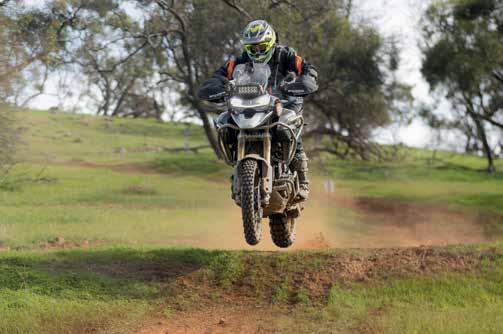

Adventure Rider Magazine has spoken to Triumph Australia’s Chris ‘Charris’ Harris on several occasions, but most recently in issue #46 when he showed us around his BMW R 80 G/S PD.
Chris is himself a veteran of an attempt at the gruelling SA 24 Hour, his 2019 race finishing early with a broken ankle. We asked Chris what prompted Triumph Australia to make the attempt at a race like this one on a bike like the new Tiger 1200, and how Cam Donald came to be involved.
“We really wanted to demonstrate the all-new Tiger 1200’s off-road capability,” said the quietly spoken Melburnian. “That’s thanks to its 21-inch front wheel and 18-inch rear, and massive ground clearance.
“To demonstrate the bike’s off-road ability, why not put it through the ultimate test? And that is Australia’s gruelling 24 Reliability Trial.”
“We got speaking with Cam. He’s done the race before. He’s won his class, and I threw out the idea. He and his best mate, Don Owen, who’s also an expert-level enduro rider, said, ‘Yeah. Let’s do it. Let’s give it a go’.
“They’re wild guys. They’re crazy. They’re up for a challenge, and they loved it. They absolutely revelled in it.” The bikes were standard production models with a few accessories. Here’s the list of changes:
Q Larger off-road footpegs
Q Removal of the fog lights
Q Addition of a 3000-lumen LED light bar
Q Removal of the centrestand
Q Removal of the pillion-’peg mounts
Q Addition of handlebar muffs
Q The screen was changed to the smaller, optional ‘Summer’ screen from the previous model Tiger 1200, AND
Q Off-road tyres.
Neither bike needed any repairs or maintenance during the event.

what worked than what didn’t,” he offered.
“The transit sections on a small-bore enduro bike are just tedious. I think the longest transit was 22km with a bit of bitumen, and the temperature dropped to -2.5 degrees after midnight and into the early hours of Sunday morning. Those sections were almost restful on the big Tiger. They were times to get a bit of energy back.”
Cam was surprised at how capable the bike ended up being through the dust, ruts, and loose rocks.
“Once I got up a bit of confidence and held on some throttle, the bike got up on top of the big river pebbles and sort of tracked along well,” he recalled.
“When it hit a rock it would hold its line. I think just the weight and bulk of it kept it tracking straight. Where I knew on a small-bore enduro bike a rock twice the size of your fist would fire the front wheel in a different direction, the Triumph just trucked on through.
“My confidence with that grew as the race went on.
“I joked about it with my best mate Donnie who was doing the same thing at the same time. He’s a very competent off-road rider and he’s full of grit, and we both agreed: when the front end of the 1200 deflects, you’re a passenger.
“It was the off-camber, wet grass, farm dam banks and few other tricky bits they’d arrowed in that were challenging. On an enduro bike they probably wouldn’t have been a big deal, but they were really tricky on the big adventure bike.
Left: Triumph Australia wanted to demonstrate the all-new Tiger 1200’s off-road capability.
Right: “Come on, Big Girl. We’ve come this far. Let’s just get each other home.”
Far right: Transit sections on the big Tiger were a chance for some recovery time.
Right main: Rear grip was lacking in the wet-clay sections.
Bottom right: A tough event. In 2022 138 started and 91 finished.
something like that. Although the suspension was plush compared to an enduro bike, in a way that sort of made us keep the speed under control, too.
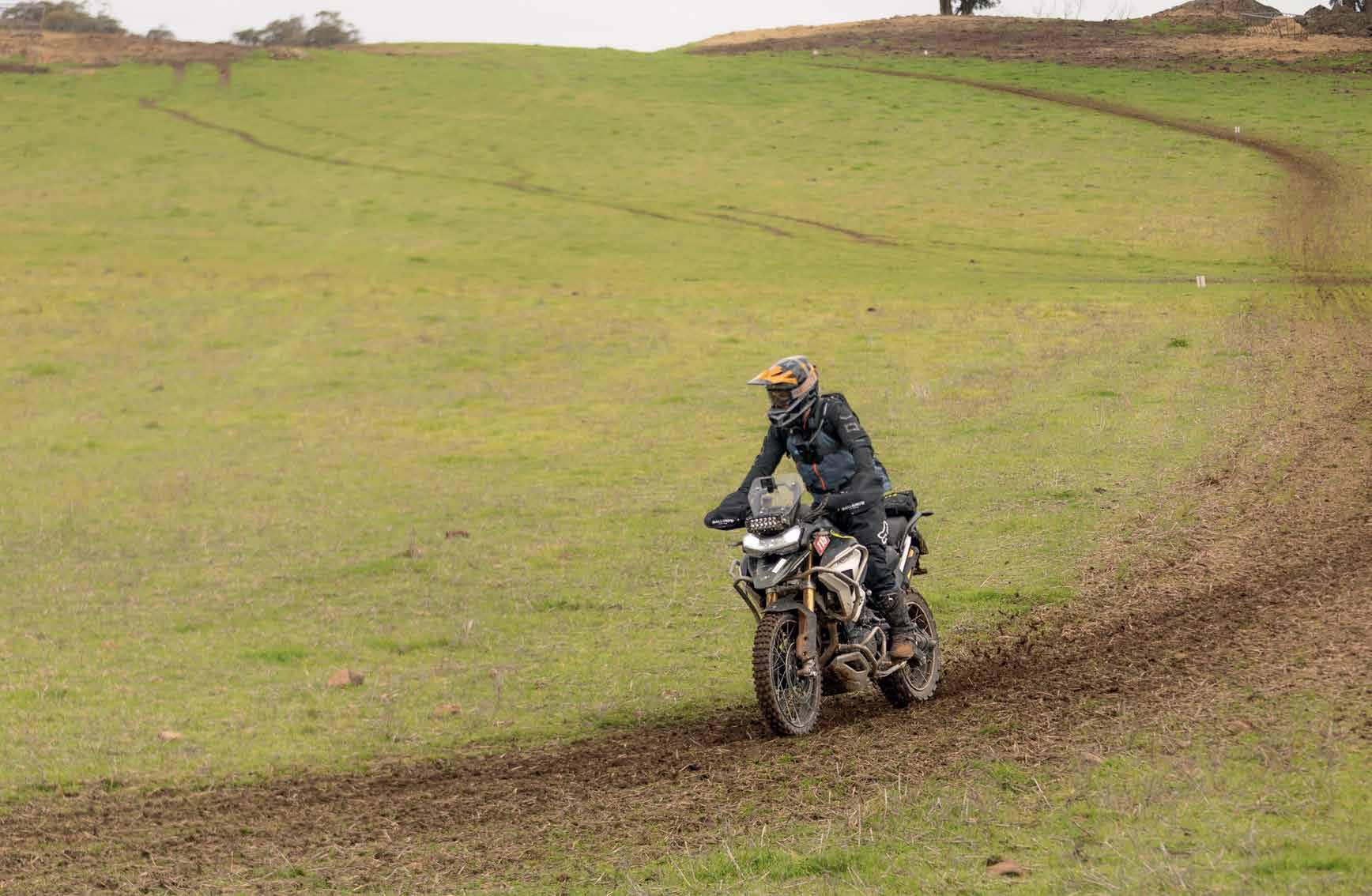
There was a fair bit of foot paddling, dabbing and survival moves to keep it upright. They were the really tricky bits. Mostly we were shaking our heads at how capable the bike was on some of the creek beds and rock ledges.”
While the bike’s performance was a highlight, there were a few things which weren’t ideal and called on rider ability and determination to make the difference.
Cam explained: “First gear was relatively tall for what we were doing and required some clutch work.
“In saying that, the clutch was magnificent and never gave any grief.
I wondered about it, because I was using it for 24 hours, and I was using it a lot.
It was a challenging course and on the big bike spent a lot of time taming the power with two fingers on the clutch.
I started at number 114 and my mate was 115, so there were 114 bikes, including 20-odd sidecars, had been through first, and the track was seriously chopped up with single-rut, deep bulldust with rocks in it. There was a lot of clutch use.
“Also, the stock suspension was very plush.
“In a way I was critical of that when first rode the bike. But then we got to the point where if we’d had a lot more support in the suspension I think we would probably have hit the squareedge bumps harder and would probably have ended up breaking a wheel or
“Man! Did I hit some stuff hard,” he laughed. “Especially on that last lap when was talking to the bike and saying, ‘Come on, Big Girl. We’ve come this far. Let’s just get each other home’.”
“A couple of times I struck a few really solid, sharp-edged bumps. At the end of the race I had a good look over the bike and there was a gouge in the side of one rim, obviously from some of those big, rocky, creek beds, but not a single ding, and I was shocked. The Tigers obviously have bloody good rims.
“We left them running tubeless and I ran 28psi front and rear. I was warned that pressure might be a little low, but after the first lap I saw the special test was such slow speed, and I thought, ‘That tyre’s not compressing much.’ I thought, ‘Nuh. I’m going to try it: 28psi front and rear both bikes’. And we had no issues.”
In what was unarguably an extreme feat of riding endurance and skill, there were a couple of factors which made things particularly difficult.
“I’d probably say two things equally,” yawned the exhausted rider. “First was the cold. “This year the temperature was below zero for about eight hours. That was tough. I’d tackle a special test, muscle the bike through what might’ve been 14km of very technical going, come out the other side dripping with sweat, and face a 20km road transit where the cold struck through to my bones.
“But would say, without doubt, the biggest challenge was picking up the bike. I dropped it three times on the second lap, and touch wood, I didn’t
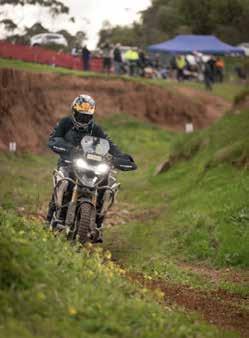
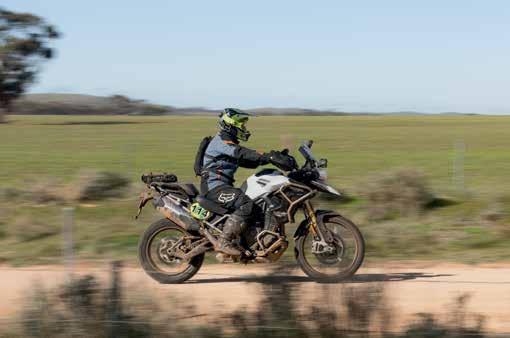
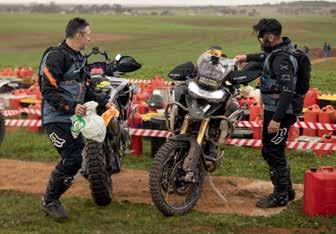
drop it again for the rest of the race.”
“I learned the idiosyncrasies of how the bike coughs out and I was clutching it with a quick throttle blip in the tight corners. I knew I couldn’t afford to let it fall over because if I did…I was so fatigued. I didn’t know if would’ve been able to pick it up again.
“I’m short in the legs, and that last time I picked her up, on lap two, I thought to myself, ‘I don’t need to be doing this 18 hours in’. It’s a big bike and I’m only 73kg. I like to think I’m strong for my weight, but I didn’t want to have to pick it up too many times.”
With a win at this event already, and a very successful international racing career, completing a provincial event could have seemed an anticlimax, but it wasn’t the way things worked out.
“You know what?” asked the hollow-eyed veteran of some of the world’s fastest and most prestigious motorcycle events, “I don’t race that much these days. I crossed the line, and looking back at it now, it feels as exciting as a big win.
“It was a crazy idea. We thought,
‘Let’s just do a lap and see where we are’. We went there to finish, but it was always going to be a big ask. It wasn’t until we really got into the race I think I realised the magnitude of what we’d taken on.
“After the first lap I thought, ‘Okay. If we can do one lap we can do two’. By the time I faced the final lap I told myself, ‘Okay. Twelve competitive stages left. Let’s just tick ’em off’.
“Every time the back tyre would slip out on that last lap I was like, ‘Oh no! I’ve got a puncture!’ To make it home was a huge sense of relief and achievement.”
Cam and Triumph’s big effort may well have an influence for adventure riders far beyond this one success.
“We spoke to the race organisers, and I know they would love to have an adventure-bike class in the future. Maybe they could tailor a few of the sections to suit the big bikes or go the sidecar route in a couple of the really extreme technical bits.
“So many adventure riders love the test of endurance, it’d be great to see that happen.”
A huge and amazing effort from Triumph, Cam, Donnie and all involved.
Donald’s teammate for the 24 Hour Trial was his childhood friend, Donald Owen – an expert-class enduro rider, B-grade motocrosser and road racer, and professional motorcycle mechanic.
In his first attempt at Australia’s oldest motorcycle race, Donnie hit a deep, square-edge hole hard and, after riding an epic 16 hours, was unable to continue, so the wild man immediately turned his attention to supporting Cam get to the finish line.
“‘DNF’ are letters nobody wants to hear in a race, and I was starting to feel heartbroken,” said Donnie, “but the support from fellow riders, who all stopped to help, and volunteer staff at the control points, was truly amazing. When I was stuck in the darkness, a guy walked almost three kilometres through the scrub with a head torch to come and help me. I’ll never forget that.
“Our next objective was to keep supporting Cam. His ability to ride at the right level – not too hard, not too slow – and maintain the right mental state to get through all the dark times was unbelievable.”

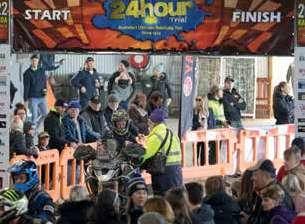
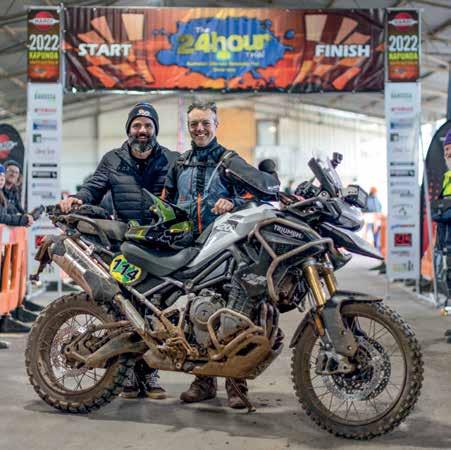

The Snowy Ride was the largest annual fundraising activity for the Steven Walter Children’s Cancer Foundation and was held in the rugged alpine region of NSW. First run in 2001, the event raised over $10 million for research into a cure for childhood cancer. Normally held on the first weekend of November, due to COVID19, the 20th and final Snowy Ride was held in early April 2022. Hopper was there. u
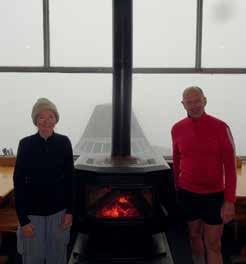
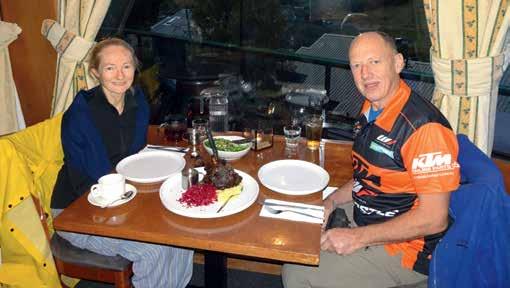
For over 10 years I’ve been attending The Snowy Ride, and this year with The Bride coming along, the packing of shoes, handbags, mountainous amounts of clothes and many other accessories meant we didn’t get away till 9.15am.
It was overcast but dry as we rode away on the KTM 890, but the rain soon fell, and we U-turned, donned the wet-weather gear and tried again, finally heading out of Newcastle at 9.30am.
Normally I’d plot a good dirt option, but with a fully loaded bike, plenty of rain in previous weeks, current conditions and a ‘monitor’ behind me, I had no choice but to accept a full day of blacktop riding.
It rained gently on and off as we trundled down the highway to Sydney, through the NorthConnex tunnel –which seemed expensive but did save time and frustration by cutting out Pennant Hills Road – then paid more tolls on the M2, M4 and M7 before finally hitting the Hume Highway and getting up some momentum.
Heavy rain set in and stayed with us for the long haul to Goulburn Bakery where wife Jocelyn, with her old-style brightyellow ‘postie’ waterproofs, was still dry.
I already had wet undies.
We fuelled bike and bodies and wriggled into more gear for warmth before taking the Federal Highway towards Canberra
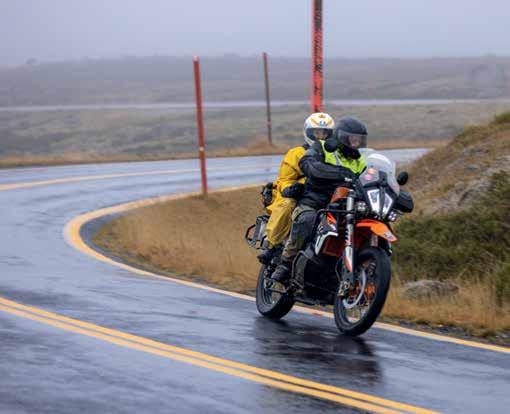
Left: Candlelight Lodge, the nearest restaurant, offered a very good feed and an evening with many other riders.
Below: On Route to Charlottes Pass and four degrees.
and a photo stop at the lookout over Lake George – normally grassy paddocks, but on this day well under water. It’s a weird conundrum as it doesn’t have any outflow of water to rivers or oceans.
We joined the Monaro Highway for a slow ride to Cooma, with many delays for numerous roadworks and, generally, the condition of the road was poor. We grabbed some basic supplies in Cooma, battled more road works to Jindabyne, then pulled up at the servo next to a flash Goldwing with a very comfortablelooking rear seat. I could tell she was considering jumping ship (all that comfort and extra luggage space was fine, I was sure, but would he be as tolerant as me?).
After a 20-minute wait on Alpine Way while a fuel spill was cleared we arrived at Jindabyne at 6.05pm after 648km for the day. It was quite cool, but I soon warmed up carrying the many heavy bags to our ‘apartment’ (then I went and got my own luggage). It was still raining, so we went to the nearest place, Candlelight Lodge, for a very good feed and an evening with many other riders.
The shop
We were up at 8.00am to find it cold and raining.
Officially the Snowy Ride is on the Saturday, so our plan for the Friday was a leisurely walk to Kosciuszko’s summit. We walked down to the Snowy Ride Shop so Jocelyn could check out the merchandise and buy more ‘stuff’ (which would somehow have to be packed into my small, allocated luggage space) then caught the quad chair up to Eagles Nest. At 1937 metres it’s Australia’s highest restaurant and has commanding views over the Thredbo Valley Track, where it was snowing, but open for the first time in several months. We were the only customers for our entire stay and we sat right in front of a roaring fire. We can recommend the coffee, pumpkin soup and sticky-date scones.
I agreed to take her shopping to prise her away from the fire. It was still snowing, the cold wind was bitter, it was way below freezing and there was zero visibility, so there was no summit walk.
u

We descended back to the village via Merritt’s Nature Trail which was reasonably protected and, despite conditions, quite enjoyable.
Merritts Gondola offered an enclosed ride to Merritts Mountain House for a late lunch and a few nips of schnapps to warm up, then we headed back to the village and I was reminded of my pledge to take her shopping. She’d browsed every clothes store in Thredbo by closing time. It’s been a good day despite the weather.
It rained through the night and was still raining when we surfaced at 8.15am, geared up in an attempt to stay warm
and dry at seven degrees.
We had our Snowy Ride card stamped for the raffle, hit Kosciusko Road to Perisher, then kept going to the end of the road just past Charlottes Pass – where the temperature was four degrees. It was a slow trip due to heavy rain and knobbies, and the quote from NSW National Park site stated: Snow Gums boardwalk has one of the greatest – and most easily accessible – views in Kosciuszko National Park. Do you want to see high peaks? They’re right in front of you. It’s like you’re in a grandstand.’
We did the short walk, knowing it would be pointless as visibility was very close to zero, but the saving grace was the coffee and hot food at Charlottes Pass
Snow Resort and plenty of friendly banter among all the crazy riders who’d made the effort to get there. After that we shivered back to Thredbo for more food and hot chocolates.
The 20th and final Snowy Ride attracted 2468 riders and culminated in a mass ride from Bullocks Flat to Thredbo village. While the softer ones had already bailed prior to the final parade there was still a good number of bikes in the procession. We found a good vantage point on the bridge to watch them all arrive, and there was plenty of fancy dress and a great atmosphere despite the rain.

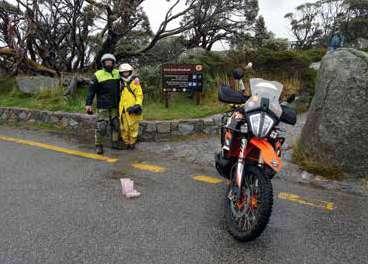
Top left: Fancy dress for mass ride.
Below left: The 20th and final Snowy Ride was held early April 2022.
Above: A good day despite the weather.
Below: Author, Hopper, and wife Jocelyn on the lookout over Lake George. The only thing wetter than the lake was Hopper.
Jocelyn in the plastic postie gear stayed dry.
Normally there’s a huge presentation outside in the mall, but due to the rain it was moved indoors, where there were some rousing speeches and presentations, including a cheque for $1 million to Professor Glenn Marshall and the Kids Cancer Centre to fund ongoing research.
There were plenty of options to party on into the night, but us oldies got fish and chips and watched Death On The Nile. We were packed and away by 9.15am the next day. It was still raining, and after a good run to Cooma we stopped at the Snowy Hydro Discovery Centre where free coffee was available for registered Snowy riders, along with a selection of pies and cakes for sale.
Roadworks made it slow going to Canberra, past Goulburn and to a stop at Pheasants Nest for fuel and snacks and, thankfully, to remove the wet-weather gear for the first time on the trip.
After 15 clicks of lane splitting around Picton it was a good run to arrive home at 5.45pm.
Although it wasn’t a hard-core dirt adventure, it was for a very worthy cause and an enjoyable few days.
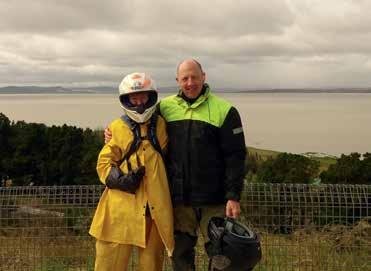
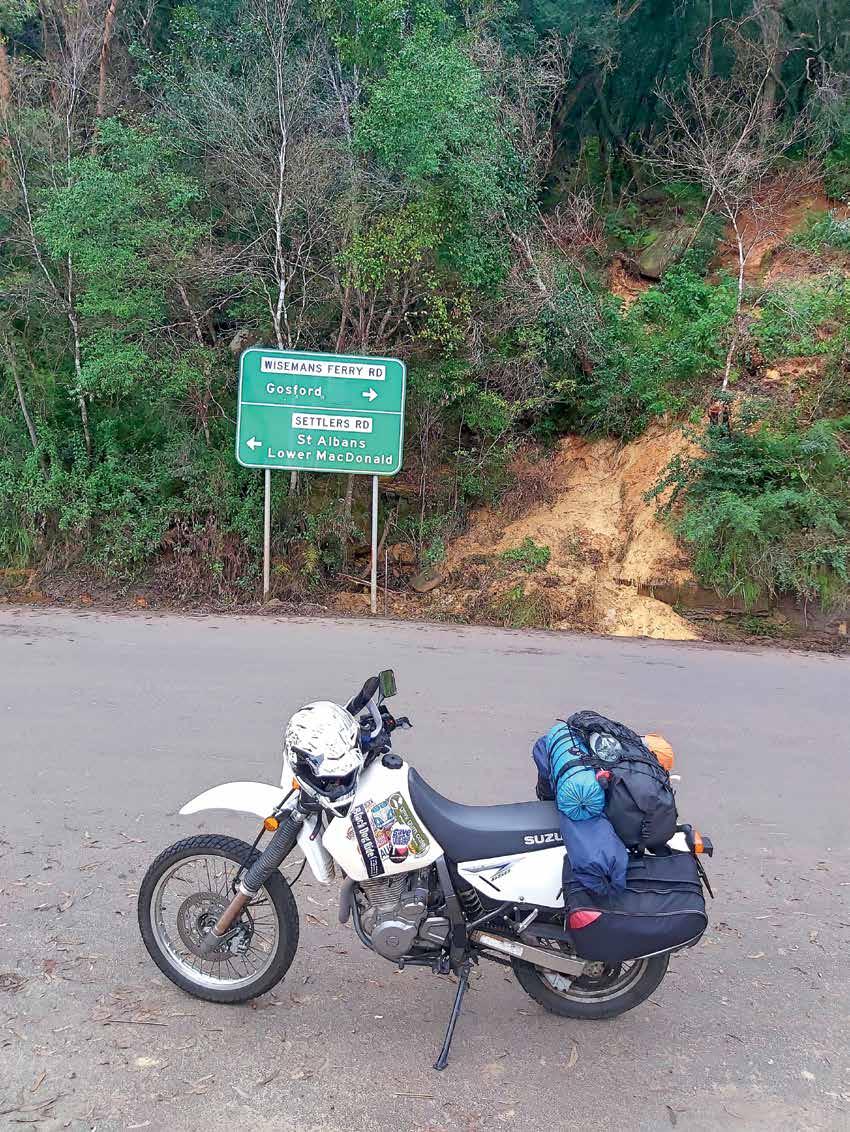
After a long break from the saddle, Rod Pedemont, Craig Morgan and author Bob Wozga organised a trip. The aim was to get the cobwebs off and check camping gear in preparation for a planned ride to the South Australian and Victorian borders via Broken Hill.
u
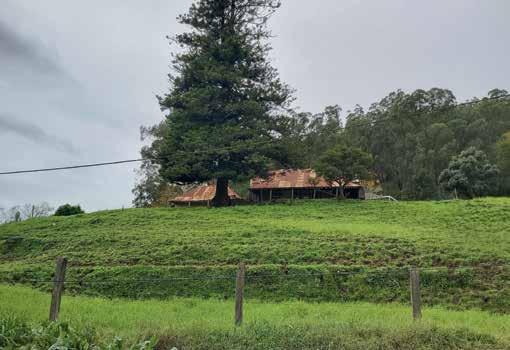
022…and thank God it’s not 2020, too.
In the past couple of years we’ve for the most part survived bushfires, COVID19, lockdowns, mouse plagues, floods and a federal election. We still have a lingering La Niña that looks as though it will have everyone soaked for a while yet. Nevertheless, we will come out of this stronger and make better decisions for the future.
The ride to Lake St Clair near Singleton, NSW, tested the steeds along the Putty Road through Broke and into Singleton, fortunately on one of the few days of sun this year.
We made the most of it.
Due to being a diligent worker, I’d organised to meet Rod and Craig a day late at the Lake St Clair campground. This wasn’t such a bad thing as it gave me time to take the scenic route via Windsor,
Ferry and St Albans, before heading through Broke and beyond.
The devastation of the year’s floods was still evident as I headed north from Windsor. Debris hung off power lines, piles of ruined furniture lay outside houses and the Hawkesbury River was still brown.
The people persevere.
I hadn’t been to Wisemans Ferry for about 30 years, and it didn’t look like it had changed over that time. From the perspective of a history buff, that’s probably not a bad thing.
Cars were already aboard the ferry waiting to be shipped to the far shore at the end of Old Northern Road, and after crossing the aftershock of the March floods was again readily evident. A landslip had closed half a section of road and traffic lights managed the flow of vehicles. Further along, mounds of sand had been pushed to the side to allow residents and travelers to get through.
The northern side of the river had an
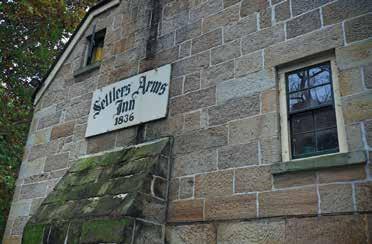

Left:
Above: Serenity.
Below
atmosphere of ‘oldness’, if that’s a real word. Colonial buildings behind old fences dotted paddocks as I followed the narrow dirt road. On the walking track of the Great North Road ghosts of convicts in a chain gang sat on the side of the thoroughfare, and I imagined I could hear one of them: “There must be some way out of here,” said the joker to the thief. “There’s too much confusion, I can’t get no relief.”
He was ahead of his time.
Weathered headstones of the St Albans Old General Cemetery came into view as I approached a bend. The remains of those who pioneered the Hawkesbury lay there, and many inscriptions had been weathered; a couple belong to First Fleeters. At a time when we’ve heard so much about people demanding freedom, crying about isolation and a need to be defiant, I had a look around and
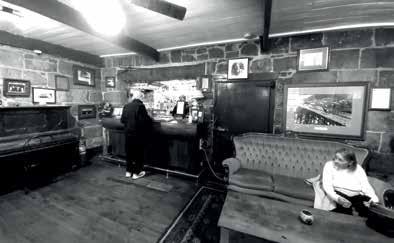
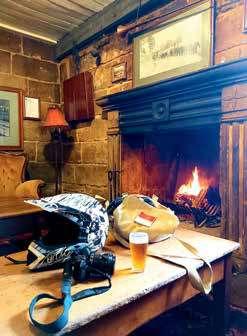

Top: The glowing fire warms the room and a schooner glass is always half full.
Top right: A moss-covered VW Kombi in the beer garden
Above: Weathered headstones of the St Albans Old General Cemetery. A couple belong to First Fleeters. Below right: Fuel at Laguna.
couldn’t help but think how some of these people had stolen a handkerchief or a loaf of bread to feed their family and were transported halfway around the world and forced to build a road to God knows where. Others came to virgin bush and defiantly created an existence for themselves and their families.
You have to admire the stoicism of those people.
The village of St Albans sits on the banks of the Macdonald River.
Once its spirit was centered on the church, but now the spirit is centered in the bar of the Settlers Arms Inn.
Originally called The Travellers Rest, the establishment is a sandstone oasis in the middle of nowhere and a welcome stop for an ale. A glowing fire warms the room in the bar and a schooner glass is always
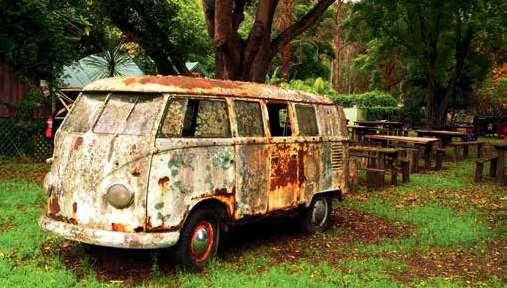
half full. During the March floods the pub provided shelter, food and WiFi to several stranded residents for between eight and 10 days. Relics of the past decorate the walls while ghosts walk the corridors. Rules of the tavern state: ‘Four pence a night for bed, Six pence with supper. No more than five to sleep in one bed’ – I guess there weren’t too many women in St Albans at that time.
Artefacts of a bygone era lay around the village. A broken-down Jeep rested on the roadside in its natural state – now home to a brood of chickens – while a mosscovered VW Kombi decorates the beer garden. Once an important agricultural area for the colony, the Macdonald Valley later went into decline due to the expansion of railways and greater tracts of farming land west of the Great Divide. The valley became a backwater and was referred to as Forgotten Valley.
On the outskirts of town, I came across St Albans Common. These Commons were established
nearly 200 years ago for the commoners – ‘locals’ – to collect firewood and spell or graze stock. Covering an area of 1000 hectares, the common was issued by Governor Brisbane in 1824 to the locals as compensation for their small blocks. It runs for 10 kilometres from Mogo Creek along Wollombi Road.
Lake arrival
In keeping with the colonial atmosphere of the track, a herd of cattle was being driven along the far tree line by half a dozen people on horses. I stopped to take some photos, but they were too far away to get a decent shot. It’s things like that you only see on TV. The distant crack of a whip and bellowing of cattle really transported me to a distant past.
Entering Yengo National Park, the road followed the meanderings of Mogo Creek before rising out of the valley and meeting the Great Northern Road.
Wisemans Ferry to Bucketty along Settlers Road and Wollombi Road isn’t

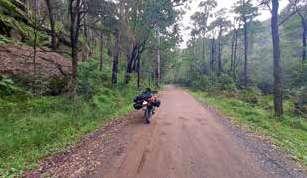
challenging, but it’s picturesque with plenty of photo opportunities.
The next convenient fuel stop after Wisemans Ferry is the Laguna Village Providore and Old Northern Trading Post. Not only can you fill the bike, but you can also get a coffee, listen to live music, get a bottle of shiraz or stock up on local produce. You won’t be disappointed if you stop in.
Through Wollombi, Broke and into Singleton the road was still potholed in sections. With the inclement weather, as soon as the roads are repaired, they’re washed out and damaged again.
A note to first timers riding through Singleton in the afternoon: traffic is as bad as Parramatta Road on a weekday.
A half-hour ride on undulating hills through fine drizzle took me at last to Lake St Clair campground.
All set
Named after the homestead lost beneath the water in 1983, Lake St Clair is a manmade lake created as part of Glennies Creek Dam to help manage water flows from the Hunter River. It’s now a popular fishing, boating and water-ski playground for the region. The campgrounds are very well maintained and serviced by a shop at the gate that sells fishing gear, firewood, ice and other supplies. Bookings are essential and must be made online at https://bookings8.rmscloud.com/Search/

Top
No
Below left: There’s nothing more calming than a crackling fire, a cold ale and a few stories and dad jokes.
Below
A
Index/10480/1.
Luckily, Rod and Craig had secured a prime campsite overlooking the lake with a short walk to the showers and barbecue facilities. Covering the fire was a tarp that made tapping sounds as it prevented the rain from dousing the flames. There’s nothing more calming after a long ride than to sit beside a crackling fire with a cold ale and listen to your mates’ stories and dad jokes. Dull music drifted across the distance from other campsites and a group of kids kicked a ball in the rain. The guys were more than satisfied with the way they’d prepared their bikes and camping equipment. They figured they should be ready for the Broken Hill adventure.
Log off
No visit to Singleton would be complete without visiting the Australian Army Infantry Museum. The exhibitions show
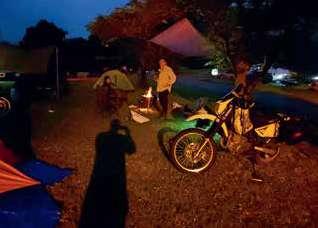
a history of Australia’s operations, from 1885 in Sudan to current deployments in Afghanistan, as well as a collection of small arms and training aids. There are so many forgotten deployments Australia has been involved in: Boer war, Boxer Rebellion, Japan, Korea, Malaya, Borneo, Vietnam, Somalia, Rwanda, Cambodia, East Timor, Solomon Islands, Iraq and Afghanistan, for instance. The Australian infantry has a huge history of helping keep the world safe.
Following Rod back to Sydney via Broke we pulled into the Wollombi pub for lunch. Surprisingly, there was very little traffic, which may have had something to do with the election or maybe just that it was raining.
A detour took me to Terrigal to visit family and, dining on hot fish and chips, watch the sun go down over the bay.
There’s a lot you can pack into a weekend ride out of Sydney and loads to discover. You don’t need to travel 1000 kilometres to be in wilderness, you don’t need to be interstate or overseas to ride fantastic roads. You don’t even need to complain about lack of freedom. When you see the hardships endured by our early settlers, or when you realise where our infantry has been deployed to help those countries keep their freedoms, we have it pretty darn good here.
Thanks to Rod for organising the ride. Craig, I still owe you for the firewood.

As bikes become heavier and more complex, and the rider’s input is increasingly filtered through invasive electronics, AJP’s PR7 Adventure is a shining example of the kind of motorcycle that made us all want to ride in the first place.
Portuguese company AJP has been producing bikes for a few decades, and the PR7 has been blasting around the edges of the Aussie adventure-riding scene for a few years.
It’s an interesting bike. The 603cc, single-cylinder, fourstroke motor from SWM isn’t new to Australians, nor is Sachs suspension or Brembo braking. But in a time when more riding modes and rider customisation seems to translate to more sales, and the more intervention the better, AJP apparently backed itself to know what a good bike was all about and didn’t feel the need to offer multitudinous tuning options.
The big thing which had us catching our breath about the PR7 was there being no ‘electronics’.
We were really happy there were no selectable rider modes and we didn’t have to connect it to a phone. All we had to do was
adventure-bike standards, and something which potential buyers will need to consider, but the payback is ground clearance – a whopping 310mm.
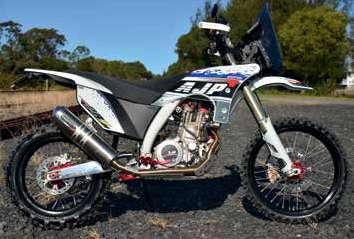
climb on the bike, hit the button and start riding.
Here it is. The PR7 Adventure. Did the company get it right?
After a very short introduction to the PR7, we think AJP did well. We thoroughly enjoyed the PR7 and look forward to some serious riding on it in the future. It won’t be for everyone. No bike is. We think ‘serious’ riding is what the PR7 does best, even though it’s clearly a lot of fun for a recreational blast as well.
The next thing that made our eyebrows disappear up into our Shoeis was the height of the thing. Not so much the seat height, because we weren’t too uncomfortable about that, but it was a long way to lift our Sidis up onto the footpegs, and heaving our lithe, muscular frames into the attack position felt like being on a short stepladder.
The seat height is listed at 920mm, which is tall by today’s

Another thing that made us do a double take was the feel of the bike when we started riding. We could actually feel the motor thumping away, and there was a considerable throaty growl when we twisted the throttle which we hadn’t noticed when the bike went past the camera. It was a stiffy-inducing sound which seemed a gift exclusive to the rider. For bystanders the bike was actually fairly quiet. It turned out to be induction growl, and straight away transported us back the 1990s and the Husabergs of that time.
The PR7 is definitely an interesting bit of gear.
To cover off the overview of the bike, the motor drives via a hydraulic clutch through a sixspeed box and uses an Athena fuel-injection system with a 45mm throttle body. Wheels are an 18-inch rear and a 21-inch
u

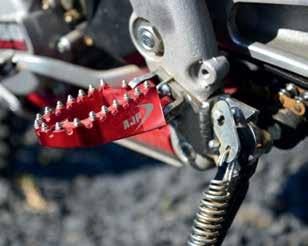



front, and Michelin Enduro Mediums graced both ends. A single-piston caliper and 240mm disc does the bizzo at the rear and a twin-piston caliper grabbed a 300mm disc up front.
Finally, Sachs suspension both ends is fully adjustable, with a 300mm stroke on the rear and 280mm on the front, and the tank holds 17 litres.
The suspension travel, ground clearance and seat height should give a fair idea of the type of terrain the bike is designed to cover, but added to that is a very slim feel about the bike in general and a firm, flattish seat that makes it easy for the rider to move around.
There’s no weight listed on the material we have available, and we don’t want to make gooses or ourselves by offering a wild guess that turns out to be hopelessly off the mark, but for a 600cc four-stroke single, this thing feels really light. Compared to the Ténéré 700 Shop Bike, for instance, the AJP feels like its half the weight and twice as nimble.
The touch screen is a big bugger at 20.3cm – eight inches for those old enough to remember – and sits in a rally tower which drips racing cred. The tower also holds a couple of Hella rally lights. We didn’t get to ride the bike at night, but if the lighting’s as good as the other standard equipment, we’re betting it’s well up to the job.
Above: Transport sections are no problem for the AJP.
1: Made by SWM. The decal says ‘650’ but the spec sheet says 603cc.
2: A high proportion of the bike’s ancillary gear is made in-house at AJP in Portugal.
3: We relied on the LCD display for the kind of information we wanted at a glance. It was easy to read and worked well.
4: The Sachs suspension front and rear is a definite highlight.
We didn’t get anywhere enough time on this bike to give solid, in-depth critique on its performance, nor to spend time working with the touchscreen which, untouched, seemed to be offering stacks of info. Magoo, from Ipswich-based dealer Mad ADV, who’s clearly a huge fan, supplied the bike and sent us off on our own to do whatever we wanted with the bike. We thought that was a big demonstration of his faith in the AJP, and possibly even in us – especially after we’d given him directions which left him wandering around lost in the northern NSW rainforest. He was very knowledgeable and gave us some good info we otherwise wouldn’t have discovered in our short time with the bike. Ease of access to the airfilter was a good one – four Phillips-head screws on top of the ‘tank’ – but there was plenty more. A steel rear subframe and has threaded bolt holes ready for racks AJP Motos has available, and the subframe is plenty strong enough to carry gear; the fuel pump is on top of the fuel tank under the seat and is easy to get to; handguards, nav tower and all the gear you see in the pics here is standard, except for the mirrors, which were Magoo’s own choice; and dual radiator fans are standard. It’s an impressive package.
The good bit
The bike we rode was in LAMS configuration, which meant it was running something like 45 horsepower. For around $1350 AJP Motos offers a pipe and ECU remap which will lift the power output to around 60hp – we have a little bulge in our strides just thinking what that must be like – and that’s thanks to the Athena ECU (previous PR7 models ran the Delphi, nonadjustable ECU).
The bike had been ridden a little to run it in, and as far as we could tell from the

gauge it was fully fuelled. We set off on a loop we knew well and, the more we rode, the more we wanted to push harder.
At 45hp it may seem the PR7 is no monster, and it’s not. But the handling and balance are so well sorted even fairly average riders will be able to wring seriously good lap times from the hard-driving donk. We know we did.
But even better than the motor’s performance is the way the whole bike feeds information back to the rider. It’s been a very long time since we had the thrill in the gut where every rut and ripple under the wheels came back to us through the ’bars and ’pegs, and we mean that in a good way. The suspension works really well, and we suspect pushing it hard would show it well capable of race pace over rough terrain. The bike never wanted to take off on its own and not once exploded with unexpected power or did something wild on rough or choppy ground. The motor was strong and torquey and the handling really good. It didn’t take long before we found old, lifelong habits which we thought long buried making themselves felt. Moving bodyweight around has a big influence on the bike’s behaviour and there’s an absolute glory in lining up
a corner, picking the point of attack, then throwing the weight forward with just the right touch of brake to drive the front wheel down for traction, feeling the millisecond of terror as the berm begins to crumble. Then, as the world threatens to disintegrate, cracking open the throttle and having the rear spin, catch, and catapult the bike forward into the next sector.
surf around the web forums will show plenty of Australian AJP owners of previous years loved their bikes but were extremely unhappy with after-sales support from the importer.
u
Above: The PR7 is light and very manoeuvrable for a 603cc single.
Below: Slim and very easy for the rider to move around on.
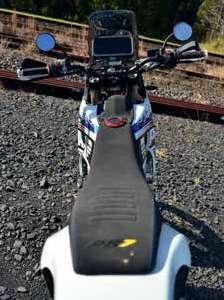
AJP Motos Australia is now in the care of a new team who are not only AJP owners, but huge fans of the bike and determined to build the brand and make owners happy.
“We took it on so there’d be support with spares and we’d start bringing bikes back into the country,” said a spokesman.
“We believe it’s the only bike you can buy at the moment that you can take straight off the showroom floor and ride in the bush. It comes with the fuel range, handguards, bashplate, nav tower, steel subframe, it handles really well…we believe they’re good value for money.
“We’re hoping to bring in the SPR range of the 125, 250, 310s and 510s as well. We have to get those ADRed yet, but that would allow us to bring in a full range of bikes, and hopefully build the dealer network.
“When we bought in this first shipment of PR7s we also did the biggest spare-parts order AJP had ever had. We did that because of where we are, because of the distances involved in getting material to Australia. At the moment air freight’s out of control, so it was important to have stock on hand.”
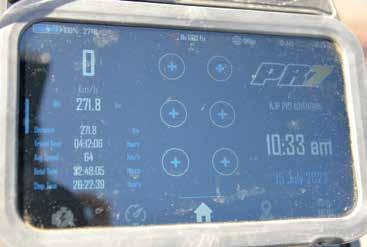
We feel like electronics and the weight of modern bikes has taken a lot of the white-knuckle thrill of that type of riding away from adventure riders. But it’s what we felt the AJP was all about, and we had to hold back a moist little tear at the memories and joy the PR7 brought to us.
After our short ride we think the big problem for potential buyers will be understanding what they’re taking on with the PR7.
It’s definitely a dualsporter. It’s ADR-compliant, holds freeway speeds and better with no problem at all, and we imagine it would make a good commuter. But it’s not a DR, KLR or Ténéré. It’s firm, the rider feels the motor and the terrain, and long bitumen hauls wouldn’t show the bike at its best.
But get it in the dirt under an aggressive rider, or even a rider who’s looking to build their off-road skills to above-average levels, and it’ll be stellar. Right at home and in its element. Naturally that leaves us wondering at how the powered-up version must feel.
We’re drooling at the thought of finding out.
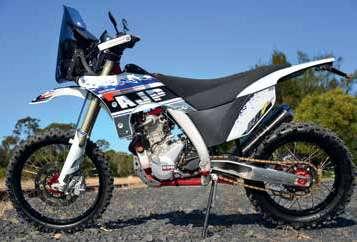
Recommended price: $17,990 plus on-roads and dealer costs.
Web: ajpmotos.com.au
Engine: Single-cylinder, four-valve, DOHC, liquid-cooled four-stroke
Capacity: 603cc
Bore and Stroke: 100mm x 76.4mm
Fuel system: Athena fuel-injection system Ø45mm
Starter: Electric
Clutch: Oil-bath, multi-disc
Transmission: Six-speed
Frame: Composite aluminium/steel
Seat height: 920mm
Wheelbase: 1540mm
Ground clearance: 310mm
Fuel tank: 17 litres
Front tyre: 90/90-21”
Rear tyre: 140/80-18”
Front suspension: ZF Sachs Ø48mm close-circuit – 300mm stroke – fully adjustable
Above: We’d heard about ‘eight inchers’. Now we’ve seen one we understand why everyone’s so impressed.
Below left: Hella lighting looks the business.
Below: A washable paper airfilter is easy to access and service. Below right: Smooth lines. Nothing to catch on boots or pants.


Rear suspension: ZF Sachs prog. System with reservation – 280mm stroke – fully adjustable
Front brake: Two-piston Brembo caliper – disc Ø300mm
Rear brake: Single-piston Brembo caliper – disc Ø240mm
Warranty: 12 months
Service intervals: First service at 1000km, then every 5,000km
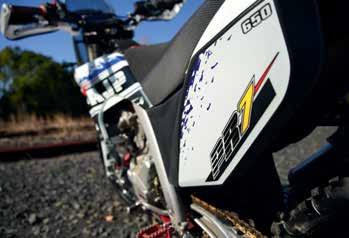
Hoo-fricken-ray. Australia’s biggest and best adventure-riding gathering is up and running again. And it’s about bloody time!

Geez. This whole Congregation thing is a bit of work, eh?
We’d kind of forgotten.
But it’s back. We’re back!
On track and on the attack!
The Vickery family – there’ll probably be even more of them now – are in the starting gates, the bain-maries are warming up, and Green Valley Farm is in better shape than ever.
The 2022 Congregation is go!
Same great venue. Same great people, and, best of all, the same
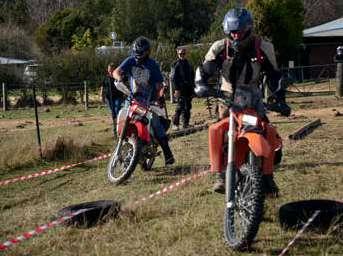
great sharing of adventure yarns, looking at bikes and being around a stack of socially distancing people who love adventure riding and bacon-and-egg rolls as much as you do.
Our bottom lips are trembling at the sheer wonderfulness of it all.
Kathy and all the folks at Green Valley Farm are busting for the event to kick off again, but have a few safety measures in place to make sure
Above: Green Valley Farm is in better shape than ever.
Below left: The gymkhana will be on again, for sure.
Below: There’s oodles of camping room.
Top right: Cabins are booked out, but Ha-ha! We got one!
Right: Great people, guest speakers, accessories and everything else that was so good before bastard COVID came along will be happening. We hate that fricken virus!
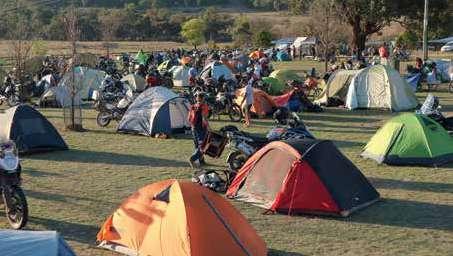
everyone’s well looked after.
“The catering will be as good as always,” chicken-salted Kathy when we phoned, “but we’ll make sure people can space out from each other a little. We don’t have it completely worked out yet, but we may serve from different locations so people don’t have to form large queues, and we’ll probably encourage everyone to take their food away instead of all sitting in the wool shed as we used to.
“We’re all learning to live with COVID, but we still have to be a little careful.”
She’s a sensible girl, that Kathy. Aside from meal times, everyone will be encouraged to spread out just a little more than previous years – lord knows there’s no shortage of room – and TF has even promised to wash his hands if he gets into another poo-flinging fight with the monkeys.
So it’s all looking good.
It ain’t broke…
Aside from that, the 2022 Congregation will have all the things that have worked so well in the past. We haven’t nailed
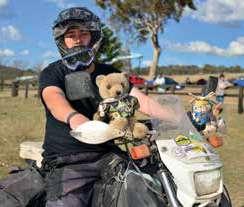
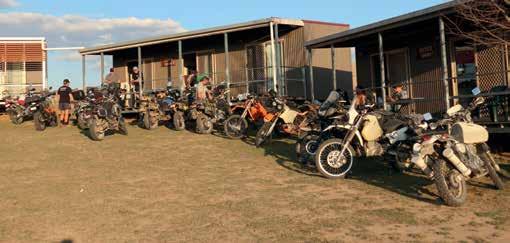
everything down yet, but guest speakers, skills demos, the gymkhana, an adventure loop…crikey. We’d better stop messing about with this magazine and get started on making some of this stuff happen!
The cabins have been booked out for yonks, but there’s plenty of campsites available, and enough hot water to cark any virus crazy enough to think it could tackle a bunch of adventure riders.
And make sure you give Kathy a call
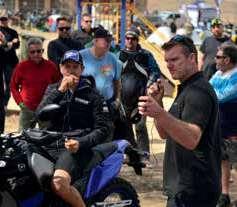
on (02) 6723 3015 to book in before you roll up or there’ll be no tucker for you. Or anywhere to sleep. Or any chance of going in the prize draw. Bugger! There’s another thing we have to organise!
Green Valley Farm 161 Jones Road, Tingha, NSW
September 17
Get the details and latest news at:
advridermag.com.au/our-events. Be there.
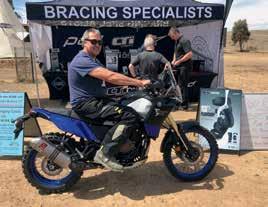

Content creator Adam Riemann and motocross legend Ben Townley scored a dream trip to Spain to ride the 2023 Ténéré 700 World Raid.
When the call came from Yamaha Motor Europe (YME) there were two spots available on the Ténéré 700 World Raid launch, Yamaha Motor Australia was keen to make the most of it.
The chosen pair for the Spanish adventure were movie-making enduro rider and Adventure Rider Magazine contributor Adam Riemann, and former worldchampion motocrosser Ben Townley. Both had carved careers out of riding hard and fast and both had ridden the standard Ténéré 700 extensively and were well placed to not only explore the full performance of the new model, but comment on the upgrades.
The plan was for Adam to create a movie with Ben to showcase the new World Raid – a model designed to go harder and further than the existing Ténéré 700.
Team Anzac
After a challenging series of flights –five in total for Ben from his home in Tauranga, New Zealand – the pair arrived in Alicante, Spain, where they were transported to an imposing hilltop castle with
360-degree views over Lorca for the Ténéré 700 World Raid model presentation. The pair hit it off immediately and set about planning their movie of the event riding as Team Anzac.
As the sun set over the Murcian mountains the riders were introduced to Lino Gardina, the Project Design chief for Yamaha’s successful adventure twin, and then to Alessandro Botturi, fresh from winning the Tunisia Desert Challenge on his super-trick Ténéré World Raid race bike.
After the preso the pair met with event organiser Hans Groendijk and Adam outlined what was involved in creating an engaging movie that showed the new bike’s capabilities. Hans explained resources were too scarce to allow the pair to follow their own agenda. They had to join journalists in a group ride to Granada.
It was a tough call, and one that meant Adam and Ben needed to capture footage during a fast, spectacular 300km route that combined twisting tar with fast dirt roads and technical, rocky trails. It was definitely Ténéré territory!
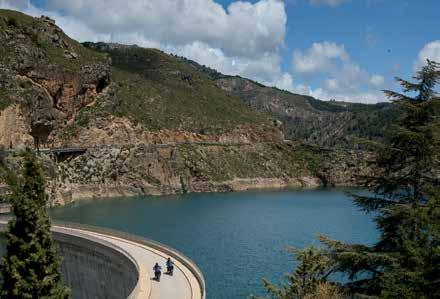
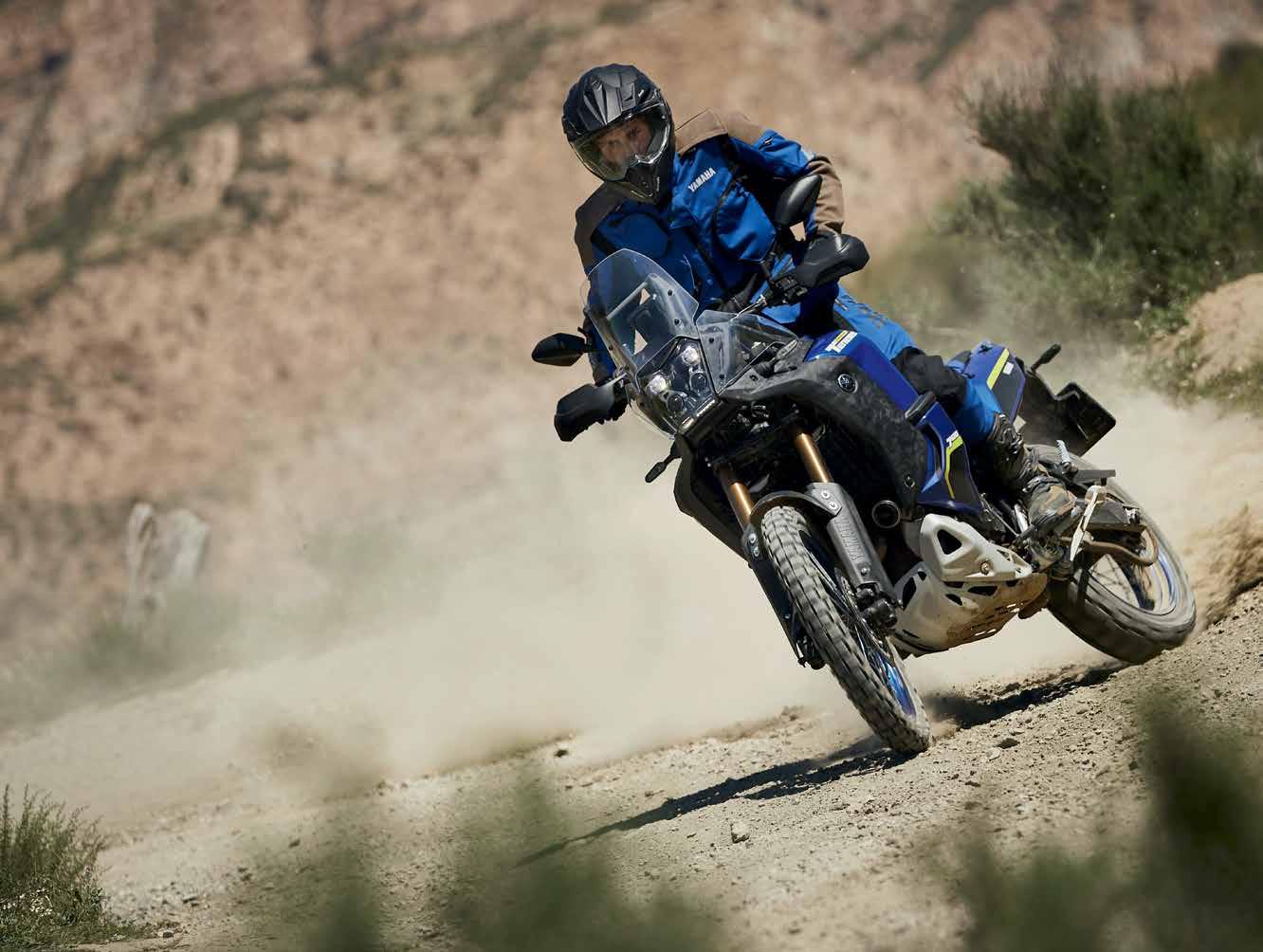
Adam Riemann and Ben Townley
Adam (left) is from Western Australia where he runs Motology Films, a platform to showcase his dirt-bike adventures. A former enduro racer, Adam spent eight years as a journalist with ADB magazine and has competed in events such as the Erzberg Rodeo and the A4DE. Motology Films: motologyfilms.com/
Ben – who gave some of the fancier Spanish dishes a swerve – lives in Tauranga, NZ, where he runs motocross training and 101 Adventures for riders keen to explore the stunning trails and scenery of both North and South Islands. The former motocrosser won the 2004 MXGP MX2 World Championship and 2007 AMA SX2 East Championship. 101 Adventures 101adventures.co.nz/


The pair had been put in the last group to depart with six other riders from Greece and Finland. There was no cornerman or GPS, and riders were kept fairly close together between and an English lead rider and Finnish sweep.
The route was a mix of twisting tarmac, dirt roads and twin track, with a spectacular Andalusian backdrop and several designated photo-stop locations where a camera and video team captured each rider as they passed. Adam intended to use the video footage to blend with his own GoPro, drone and camera vision for his Motology Youtube channel. Ben was more than happy to join Adam in his quest to create an epic movie and was super enthusiastic about the bike, the ride, the laughs, the food and just being in Spain again soaking up the culture. His successful race career had taken him all around the world, including
Europe for MXGP and the US for AMA competition, but all he ever saw of each country was the inside of airports and the layouts of the tracks. This was his chance to sample paella and sangria in authentic surroundings.
The next morning Ben asked Botturi for a ride on his Tunisian Desert Challengewinning Ténéré 700 race bike, but the answer was negative – no surprise, considering the machine was one of only two built (the other ridden by adventureand trials-riding legend Pol Tarres).
After tuning the ’bars, levers and brake pedals to their preferred positions, Ben and Adam set off with their group to the first photo location.
With years of experience in high-level competition,
including finishing the extreme enduro at Erzberg, Adam could explore the limit of a Ténéré 700’s performance. Ben’s skills had transferred directly from the motocross track to the twin track, so watching the pair drift around corners in unison was a treat for the photographers.
At the first photo stop the Anzac pair caught up with Alessandro Botturi who was riding his race bike with the Italian group. While European journalists were being photographed on a twisting dirt road, Adam launched the drone and captured himself and Ben exploring the most recently ridden trails. Then the pair had to catch up to their group, which wasn’t a problem, and they had a lot of fun exploring the limits of traction around the dry

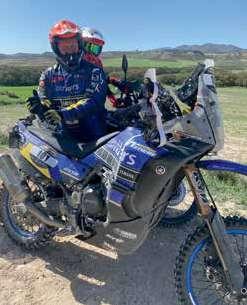
World Raid: the future
Yamaha has used the World Raid model as a base to create two very special Ténérés for the newly formed Yamaha World Raid team featuring Pol Tarres and Alessandro Botturi – shown here on his rally bike. Botturi won the Tunisian Desert Challenge in the first outing for the trick bikes – a great result for the big twin up against dedicated 450cc rally bikes.
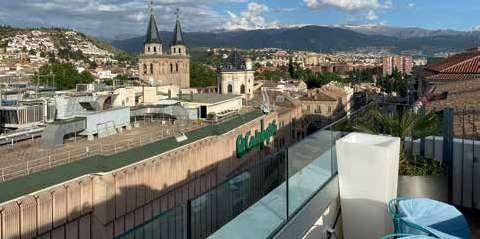
The race bikes were developed by Team Manager Manuel Lucchese who worked as Yamaha’s R&D project manager and is the brains behind Rebel X, the creators and suppliers of high-end performance parts for the Ténéré 700 rebelxsports.com/official-yamahatenere-world-raid-team/ Yamaha plans to market parts developed and tested by the Ténéré World Raid team, like the dual 10-litre rear-mounted fuel subtanks, as GYTR parts available through the Yamaha network. Fitting the tanks gives the Ténéré 700 World Raid a fuel capacity of 33 litres – enough to satisfy the most hardcore adventure rider.
Yamaha Europe also plans to offer its customers the opportunity to join rally raid events and compete on the World Raid model. In Australia and New Zealand the increased off-road focus of the model is bound to appeal to Yamaha-supported adventure-tour companies such as RideADV and 101 Adventures.
and dusty Andalusian trails.
The day continued with Adam and Ben grabbing footage whenever there was a pause for authorised photo shoots.
Drifting, wheelies and ’bar-to-’bar action for the camera showed how much both riders enjoyed the event and the capability of the new twin.
The pace was hot after lunch.
To capture the footage they needed the pair had to push on, sliding and roosting around the Spanish countryside while enjoying the banter on their commsconnected headsets. Each creek crossing became a playground with the cameras rolling, and the Greek riders on hand captured the fun on their iPhones. Adam was stoked when in one steep, loose and rocky corner Ben tried – and failed – to overtake him. It’s not every day you

accelerate away from a world champion, but Adam’s adventure-riding game is strong.
The route took a turn into a stunning valley with high, rocky cliffs providing

The Ténéré 700 World Raid is due to arrive in Australia and New Zealand around March 2023 in Icon Blue and Midnight Black colour schemes. No price is set yet. The standard model will also continue to be available. The World Raid model features a wide range of updates designed to go even harder and travel even further than the standard model, including:
Q 23-litre-capacity, dual sidemounted fuel tanks
Q Flat, rally-inspired two-piece seat
Q Five-inch, colour TFT meter with mobile notification connectivity
Q USB charger
Q Three-mode switchable ABS
Q High-specification 43mm KYB front forks with 230mm travel
Q Öhlins adjustable steering damper
Q Aluminium piggyback rear shock with 220mm wheel travel
Q High windscreen, easy-to-remove side deflectors and LED flashers
Q Fully new cockpit area and new front cowling
Q New larger rider footpegs with easy-to-remove rubber inserts
Q Three-piece aluminium engine guard
Q New aluminium die-cast engine support
Q New radiator grille
shade for the riders. Showers of roost flew from the Pirelli Scorpion STRs as the final 50km took the group on an incredible twisting dirt road from La Peza to Granada and onto a smooth, grippy surface designed to highlight the new bike’s impeccable road manners. The backdrop was the majestic Sierra Nevada mountains, snowcapped despite the 30-degree temperature at sea level. After a solid eight hours in the saddle, the group reached its destination in Granada, home of the famed Alhambra Moorish palace and gardens. Then it was straight up to the hotel’s rooftop bar for a well-earned cerveza and a debrief on the day’s ride.
“We rode the wheels off both bikes and it’s a testament to the Ténéré World Raid that we felt super comfortable doing so,” said Adam. “We were pretty confident out there and at times I doubt we’d be riding faster around those trails on any other kind of bike. It was awesome doing it all in tandem with Ben – we were in the zone,” he added.
“What an amazing experience,” frothed Ben. “To be in Spain again and riding adventure bikes around those awesome trails…it just doesn’t get any better. “Yamaha really got this bike right. All the changes made to the World Raid version are spot on. They all improve the bike,” he added, Ben should know. He runs Ténéré 700 adventure Tours in New Zealand.
At 9.30am the following day Ben jetted out of Granada on his way to Sardinia to watch the MXGP and catch up with old mates like former Pom MX gun Paul Malin. Did he sample paella and sangria? Sadly not. Maybe on his next Spanish adventure.
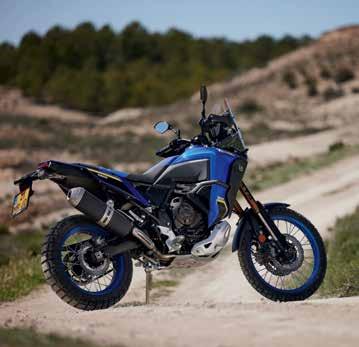
Engine type: four-valves, liquid-cooled, DOHC four-stroke
Displacement: 689cc
Bore x stroke: 80.0mm x 68.6mm
Compression ratio: 11.5:1
Maximum power: 54kW @ 9000rpm
Maximum torque: 68Nm @ 6500rpm
Lubrication system: Wet sump
Clutch type: Wet; multiple disc
Ignition system: TCI
Starter system: Electric
Transmission system: Constant-mesh; six-speed
Final transmission: Chain
Fuel consumption: 4.3l/100km CO2 emission 100g/km
Frame: Double-cradle; steel-tube backbone Caster angle: 27º
Trail: 105mm
Front suspension: Upside down telescopic fork
Rear suspension: Link suspension; swingarm
Front travel: 230mm
Rear travel: 220mm
Front brake: Hydraulic dual disc, Ø282mm
Rear brake: Hydraulic single disc, Ø245mm
Front tyre: 90/90 - 21 M/C 54V
Rear tyre: 150/70 R 18 M/C 70V M+S
Overall length: 2370mm
Overall width: 905mm
Overall height: 1490mm
Seat height: 890mm
Wheelbase: 1595mm
Minimum ground clearance: 255mm
Wet weight (including full oil and fuel tank): 220kg
Fuel tank capacity: 23.0 litres
Oil tank capacity: 3.0 litres
Warranty: 24 months, unlimited parts and labour
Colours: Icon Blue, Midnight Black
Service intervals: 10,000km. Valve clearances every 40,000km
A chance encounter had Graeme Sedgwick caught up in the past, glad of the present, and looking forward to the future.
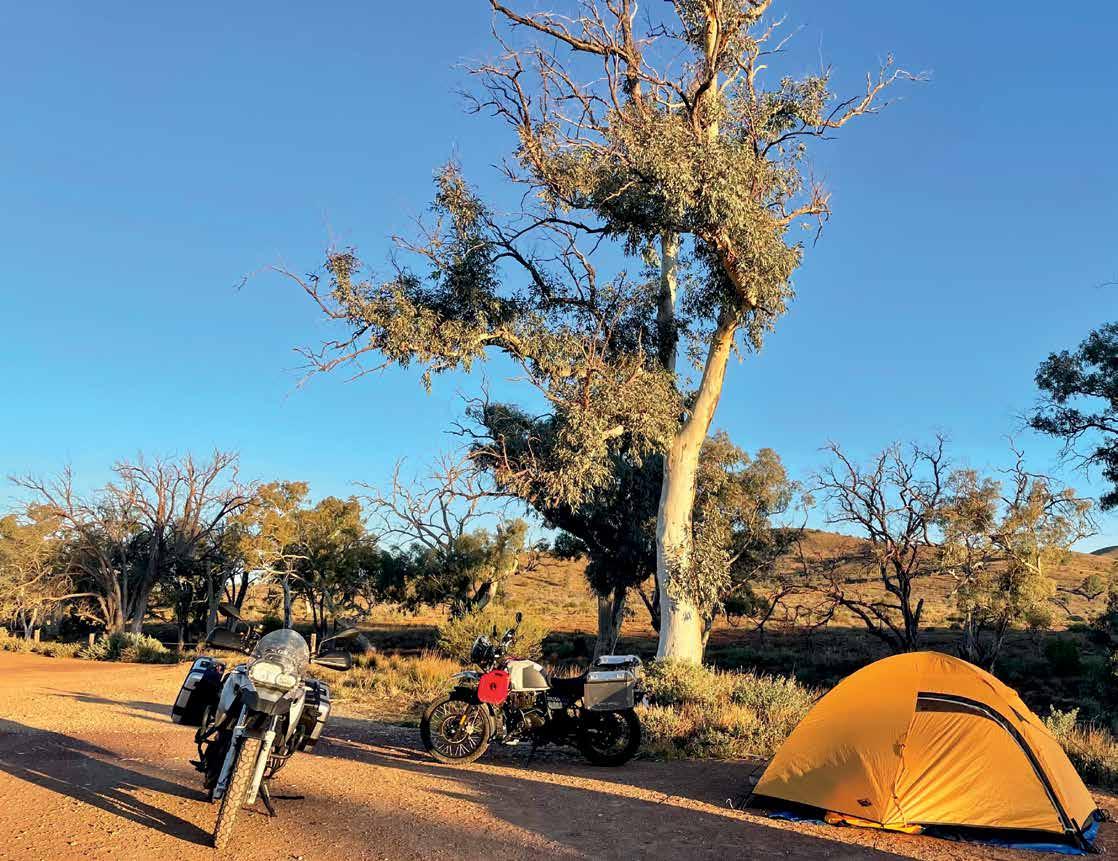
It’s a funny thing. Adventure riding is a passport to time, with or without mates, in the elements, unencumbered by the baggage of life. It’s a special kind of freedom for those who can set out to ride, sometimes for long periods and over large distances, mostly for the fun of the activity. It breaks the tedium, satisfies some new-frontier ambitions or revisits places because we just enjoy familiar country.
My point?
We all have stories about journeys, each as curious, thought-provoking and unique as the other. But none are more interesting than those stumbled upon by chance.
Weird
I was rain-saturated and frozen to the core, having ridden for what seemed an eternity against blasting wind from the planet’s icy south, when without so much as a
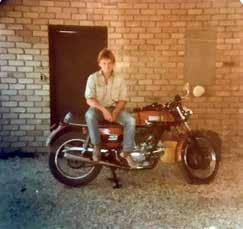
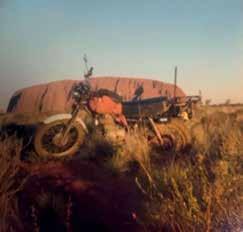
see my newest unknown friends were riders who understood my refrigerated state.
As the steaming, life-giving hot drink was handed over, and attempting to masquerade as a tougher-than-razor-blades bikeriding mortal, I stuttered, “Thanks...where you been?”
Their instant camaraderie and warmth were a joy to this sodden adventurer, and their answer revealed something of their rides.
Names were exchanged and Sharon offered some remarks on her Himalayan. Then mentioned a Moto-Guzzi which slipped into chuckles about riding in Turkey. Then came stories of recent adventures darting along some of South Australia’s best ballbearing gravel somewhere between Roxby Downs and Oodnadatta, all of which immediately aroused my curiosity and distracted me from my refrigerated state.
“Tell me more,” I eagerly trembled, at which point, Robert, her unassuming buddy, weighed in with recollections of an around-Australia ride he’d completed on an XL350 he’d purchased for $600 over 40 years before.
I was hooked!
We’d connected without a clue about each other and, frankly, who cared?
As I nodded encouragement Robert continued his narrative.
Sparked by his 1980 ambition to attend an Off Centre Run in Alice Springs he’d left Melbourne and headed north up the east coast, zigzagging in and out of places that caught his attention or beckoned simply because of their unfamiliarity. Eventually he found himself in Cairns and kept going through Noah Beach to Cape Tribulation. It was a ride, Robert recalled, that served up plenty

of memorable encounters and mixed unsealed roads and muddy, slippery surfaces, ending up at an assortment of corrugated iron sheds and a general store that sold supplies of tinned food.
With a firm resolve to attend the Off Centre Run, his return southward followed the coast, his bike needing only routine petrol fill-ups and maintenance checks, before heading southwest from Townsville via Charters Towers, Torrens Creek, Hughenden, Julia Creek, Boulia and into Alice through the East MacDonnell Ranges. It was an enormous ride of remoteness, spectacular vistas and fortunate encounters. Over four decades later Robert’s memories were still vivid.
It was the 1980s. Things were less complicated and more carefree, and he was able to stay and work in Alice after the Off Centre Run, and that allowed more rides out to, and in and around, Kings Canyon, Palm Valley and Ayres Rock.
Lucky
Later his riding took him north to Katharine and Darwin before heading west to Broome via Kununurra, Halls Creek, and Fitzroy Crossing. It was, Robert hastened to add, “A solo journey
thought of courtesy, I dived under an occupied roadside barbeque shelter and seized on a couple’s generous offer of a very much-needed hot cuppa. No doubt the offer was prompted by my blueish, iceberg appearance, which must’ve been obvious to the pair already in the shelter.
I suspect I looked like I was about to die. I certainly felt I was. Instinctively, deep within my almost-frozen condition, I could
Main: A camp at Hawker in the Flinders Ranges heading to Broken Hill.
Top: Robert still has this old Ducati.
Above: Things were less complicated and more carefree in the 1980s.
Top right: Sharon’s recent adventures included darting along some of South Australia’s best ball-bearing gravel between Roxby Downs and Oodnadatta.
Right: They clearly understood a thing or two about long-distance riding on pretty much any sort of bike. u
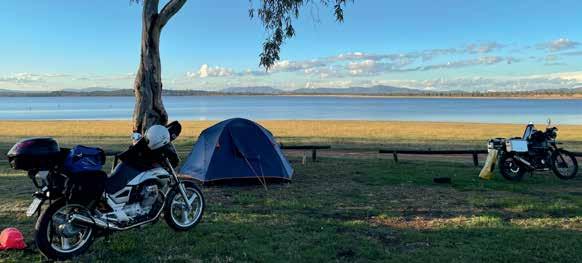
that served up plenty of surprises.”
Those surprises included running out of fuel and losing his sleeping bag. A fellow traveller who happened to be following stopped to ask if he was okay, and revealed he’d recovered the sleeping bag which had shaken itself free over the corrugations. He also helped with the fuel situation, prompting Robert to conclude there are some very kind people in this world.
With every wrinkle of his body and item of clothing thickly covered with Australia’s finest outback red talcum, Robert fell into a funny sort of outback-rider’s equilibrium – a state that helped sustain his ambition to conquer the ride he’d set himself.
On to Broome he went, south to Perth across an unsealed Nullarbor which wasn’t short on gravel, sand and stones, until he eventually arrived home in Melbourne almost six months after his departure.
Australia was conquered on a bike mechanically far less sophisticated than today’s adventure machines, and with only an assortment of very rudimentary but fundamental camping kit. Empty wine casks were used as pillows and the menu was mostly jaffles.
Robert’s long ride had totalled no less than 30,000km, remarkably without mechanical dramas or even a flat tyre, and was done on a Honda XL350 that was ultimately sold for no less than its initial purchase price.
That ride created an itch to ride further afield, so together with mate Sharon, Robert departed for the United Kingdom and bought a CX500. Without any particular travel plan the pair set off across the mother country to explore, ending up in Scotland, which turned out to be not just a wonderful place, but also one of friendliness in terms of motorcycling companionships.
After this accomplishment, loaded with confidence, the pair then crossed the channel to explore France, Switzerland, Italy, Yugoslavia, Greece, Turkey – inclusive of Gallipoli – Rhodes, Crete, took a ferry to Ancona, and eventually rode back to the UK via Austria, Germany, and Belgium. Back in UK they sold the bike for less than they’d paid for it.
“All things considered that wasn’t a bad outcome,” interjected Sharon, who pointed out it’d been snowing at the time, so they were very lucky to sell the Honda at all.
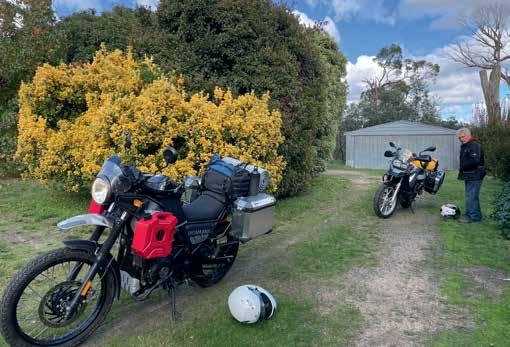
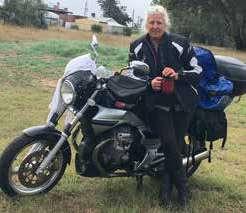
It was clear the pair had enjoyed many memorable tours and still do.
The halcyon days of waxed-cotton Belstaff jackets held great significance for both riders, and why not? Picture, if you can, touring across the northern hemisphere aboard a Honda that looked a bit like a two-wheeled gypsy’s caravan with miss-matched and odd-sized belongings awkwardly lashed to it. Compare that image to today’s highly sophisticated riding kit and luggage.
By the time the yarns had spun their web around me, I was beginning to warm to the point where I could actually feel my own blood moving through my chilled extremities. I encouraged their conversation and heard how they’d really loved Turkey, particularly its friendly people’s generous hospitality and the freshly cooked breads. Ferry crossings got the nod, particularly between Turkey and Greece, border crossing uncertainties and passport checkpoints were also a source of reflective amusement, and finding themselves shy of appropriate currency or correct currency for periods
of time also featured.
As I sat at the battle-scarred picnic table, listening and slowly recovering, I could see the pair’s motorcycling hadn’t slowed. They’d ridden in just about every compass direction possible in Australia and had plenty of plans to continue. They’d recently enjoyed riding, each on their own bikes, from their base in Central Victoria via the Grampians, Mildura, Hawker, Roxby Downs, Oodnadatta, Marree, the Flinders Ranges and into Broken Hill. They clearly understood a thing or two about long-distance riding on pretty much any sort of bike. Whether the destination was near, faraway, in between, somewhere crazy, unfamiliar or beyond, they were well-equipped to get there. It also wasn’t surprising to see their reactions when a couple of larger-capacity bikes loaded with camp rolls, saddlebags and more pulled up. As the riders and pillions unplugged their coms Robert pointed out things had certainly changed since those wine-cask pillows.
The afternoon’s sky had cleared to a beautiful blue by the time I’d recovered a sustainable core temperature and the stories were done. Thanks to the offer of a life-saving hot cuppa from seasoned riders Robert and Sharon a ‘Where you been?’ moment had become a trigger to organise another ride, or more simply thank our lucky stars adventure riding hasn’t, for the moment at least, matched the commercialisation of mainstream travel.



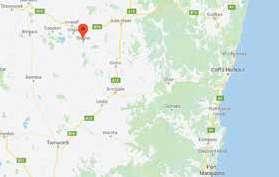
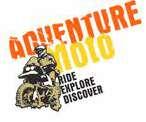

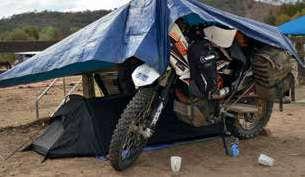


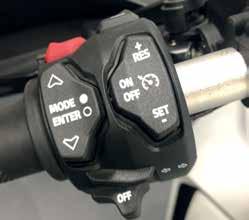
few Australian motorcycle-media heavyweights were invited to an unveiling of Ducati’s new Desert-X in the very opulent Ducati head office in Sydney. Naturally Adventure Rider Magazine was one of the guests, and when it comes to heavyweights, editor TF is always first to don the elastic-waisted pants and join the herd.
The bike was still a prototype, but very close to production-ready. It’s going to get Australian hearts racing.
The main points of the bike include:
Q A 937cc V-twin engine with 110HP
Q 21” front and 18” rear spoked, tubeless wheels
Q 21-litre fuel capacity with accessory eight-litre auxiliary tank available
Q Six riding modes with full customisation available
Q Cruise control
Q Quick shift
Q Kayaba long-travel suspension, and
Q 202kg dry weight.
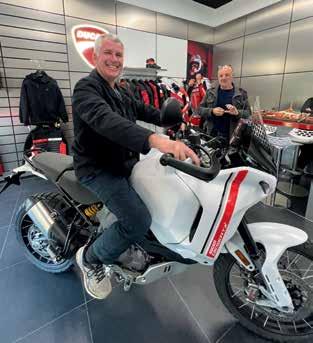

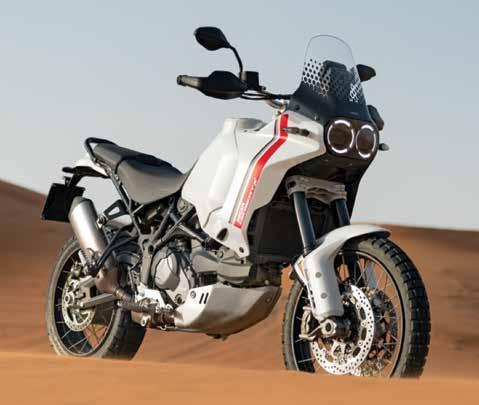
Engine type: Ducati Testastretta, L-twin cylinders, Desmodromic valve train, four valves per cylinder, liquid-cooled
Displacement: 937cc
Bore x stroke: 94mm x 67.5mm
Compression ratio: 13.3:1
Power: 110hp (81kW) @ 9,250rpm
Torque: 92Nm (9.4kgm) @ 6500rpm
As far as we could tell sitting on the bike in a meeting room, it feels quite compact with no sticky-out bits we could see. It’s slim between the knees and the standard 875mm seat height should allow a sizable percentage of Aussies to get their feet on the deck. The seat height can be altered up or down with the purchase of OEM optional seats and linkages.
We were told Australian models would be supplied with a foam filter, the standard battery is a lithium-ion jobbie, and the bike is Euro 5 compliant. Colour choice is limited to ‘Star White Silk’, the colour you see here. Recommended retail will be $24,200 ride away, and that’s a red-hot price for Ducati performance, especially if you work through the spec sheet and see what’s on offer as standard equipment.
We can’t wait to ride it.
Fuel injection: Bosch electronic fuel-injection system, 53mm throttle bodies with ride-bywire system
Exhaust: Stainless-steel single muffler, catalytic converter and two lambda probes
Gearbox: Six-speed
Primary drive: Straight-cut gears, ratio 1.85:1
Final drive: Chain, front sprocket Z15, rear sprocket Z49
Clutch: Slipper and self-servo wet multiplate clutch with hydraulic control
Frame: Tubular steel trellis frame
Front suspension: KYB 46mm upside-down fork, fully adjustable
Front wheel: Cross-spoked, tubeless, 2.15” x 21”
Front tyre: Pirelli Scorpion STR 90/90 – 21 M/C 54V M+S TL (A)
Rear suspension: KYB monoshock, fully adjustable, remote preload adjustment, aluminium double-sided swingarm
Rear wheel: Cross-spoked, tubeless, 4.15” x 18”
Rear tyre: Pirelli Scorpion STR 150/70 –R18 M/C 70V M+S TL
Wheel travel front/rear: 230mm/220mm
Front brakes: Two 320mm aluminium flange, semi-floating discs. Radial-mount Brembo monobloc four-piston calipers, Bosch Cornering ABS
Rear brake: 265mm disc, Brembo two-piston floating caliper, Bosch Cornering ABS Instrumentation: Five-inch TFT colour

Martin Kisbee and his group were hoping for a Simpson crossing, but the wild weather forced a change of plan.
Words and images: Martin Kisbee
We still had Desert Parks Passes from our previous crossing, west to east, in June 2021, but as the trip date approached there seemed to be a lot more rain than normal. Roads were closed throughout the north of South Australia, Queensland had floods and people were stranded
in a number of places. A Simpson crossing looked very risky and an alternate plan was needed. What about the Gawler Ranges?
While on the Eyre Peninsula there was also Googs Track. One rider’s work had a depot in Port Augusta where we could park cars, so a new route was worked out. But then it turned out a cousin of
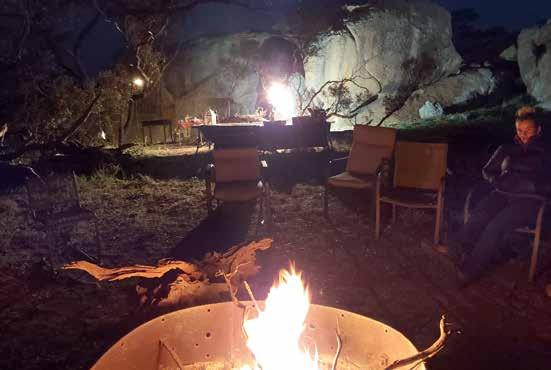
another member and her partner were managing Buckleboo Station, a property next to the Gawler Ranges National Park, and we’d been invited to stay. Great!
With bikes on utes and trailers we drove from Port Augusta to Kimba then north to Buckleboo where we met our awesome hosts and set up our tents. We were invited to a barbecue of home-grown and killed Dorper lamb, set up behind huge granite rocks with a warming malley-stump fire and a few bottles of wine. A million stars shone overhead – what a way to start a trip! The following morning, eager to get the ride started, we hit the track to Paney Station and its well-known shearing shed. There’s Telstra mobile signal at the shearing shed so you can get on-line permits if you’ve forgotten. I only found that out when my mobile rang and a relative wished me a happy 71st birthday. The tracks were in good condition and had mostly been graded since the rain earlier in the year.
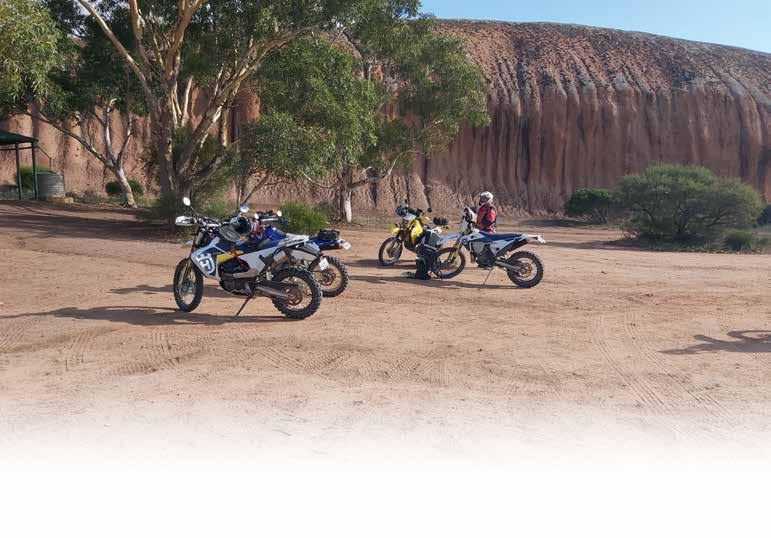
It was time to hit the 4WD tracks and head through the hills, stopping at the lookout to view the Organ Pipes. After walking to the ‘dryfall’ – there was no water on the day – and back to the carpark, next stop was Pildappa Rock, a large granite monolith similar to Wave Rock in WA.
Petrol was decanted from the Safari tank to the smaller-tanked two-stroke before we found an old, disused, sandy track called Old Princess Highway, which we followed through the backroads to Wudinna for fuel. With time getting away, and one of the bikes’ headlights not working, we got going toward a shortcut through Pinkawillini Conservation Park. Good fast roads passed by Mount Wudinna (another granite monolith) and took us to the park entry where we were confronted with deep sand which got harder, windier and more overgrown the further we went. Over and hour and 40km later
we’d conquered the Buckleboo Stock Route. It turned out to be the hardest track of our trip and we finished in the early evening with a full moon to guide us back to camp.
After a well-earned shower the shearers’quarters kitchen made dinner easy and we were soon sat around the fire under moonlight.
Next morning the group of five bikes and one 4WD set off toward Perlubie Beach.
The shorter roads had all been tarred, so trying to stick to dirt roads made the trip longer. One road was on the
map but not the GPS. Undeterred, we followed it anyway, finally ending up at a gate. Turning around I asked for directions – it must’ve been my feminine side – from someone in a nearby paddock working on machinery, and was told there was a gazetted road and we could go through the paddock and follow around the trees, a detour of around six or seven kilometres.
I was unlucky enough to pick up bit of wire in my rear wheel and sprocket, breaking the chainguard and damaging the chain, which broke a little later. We made it to Perlubie in good time to set up camp and watch the sunset from the beach.
u
Left: What a way to start a trip!.
Top: Pildappa Rock, the highest and longest wave formation on the
Right: The Organ Pipes in the Gawler Ranges is one of world’s the largest exposures of volcanic rhyolite.
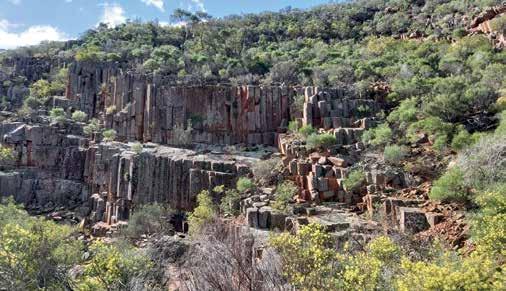

After a good night in a bush camp we headed north to the Googs Lake turn off, finding the memorial to the creators of the track. We rode on to the lake, which had water in it, before heading back to the track and heading north.
Riding the dunes was tiring.
In the Simpson the dunes are further apart which gives a bit of a break, but some sections of Googs Track are unrelenting, dune after dune, so I was glad of a breather – although a flat tyre on the rear wasn’t really the best.
There wasn’t much interest in climbing Mount Finke, so we continued on past the turn. At one stop Martin, who was driving the support vehicle, said someone off the side of the track had recognised us and called him by name on the CB. It turned out to be a friend from the Gawler 4WD club going the opposite way.
Once we reached the railway the road took us through Tarcoola, past the pub ‘opening soon’ (for the last 10 years) and on to Kingoonya. The pub there reopened a number of years ago and now is run by a previous local, and the caravan park and fuel pumps have been taken over and run by a couple who are renovating. There are donga rooms, and powered and unpowered sites from $10 per person. The renovated shower block got a workout after swags and tents were readied for
later use, before the very short walk was made to the pub for dinner. A nice, warming fire outside encouraged people to stay on after their meal.
In the morning a rider found the phone number for Nonning Station, which backs on to Buckleboo station, and received permission ride through and on private tracks to Buckleboo.
We set off south looking for Skull Camp Tank Road, and after about 50km the tanks themselves could be seen at the turn off, taking us on to the Lake Gairdner Public Access Road (PAR). A nice track ran out to a campground and parking area in front of the lake, which, with water in it, showed the reflection of the hills behind. Nice.
Back on the road we passed the turnoff to where the Speed Week races are held in
dry years, but not this year. Mt Ive Station charges $40 to drive the tracks out there now apparently, and $80 to drive all its tracks. We passed the two wooden wagons and stopped at the station gate for pictures of the submarine, then sprinted down to Nonning Station. Because of the wet weather Nonning was green with grasses and running with sheep, ’roos and emus. Passing the ‘no entry’ sign off the PAR, we rode wonderful countryside, zigging and zagging on farm tracks, with only one turn around, until we arrived at a gate we assumed was to Buckleboo Station. A dead-straight track followed a fenceline to the horizon, and Buckleboo Road ended 80km of awesome station tracks.
Turning left when we reached the road meant we had less than a kilometre to end our ride, just in time to settle down for the last night around the campfire.








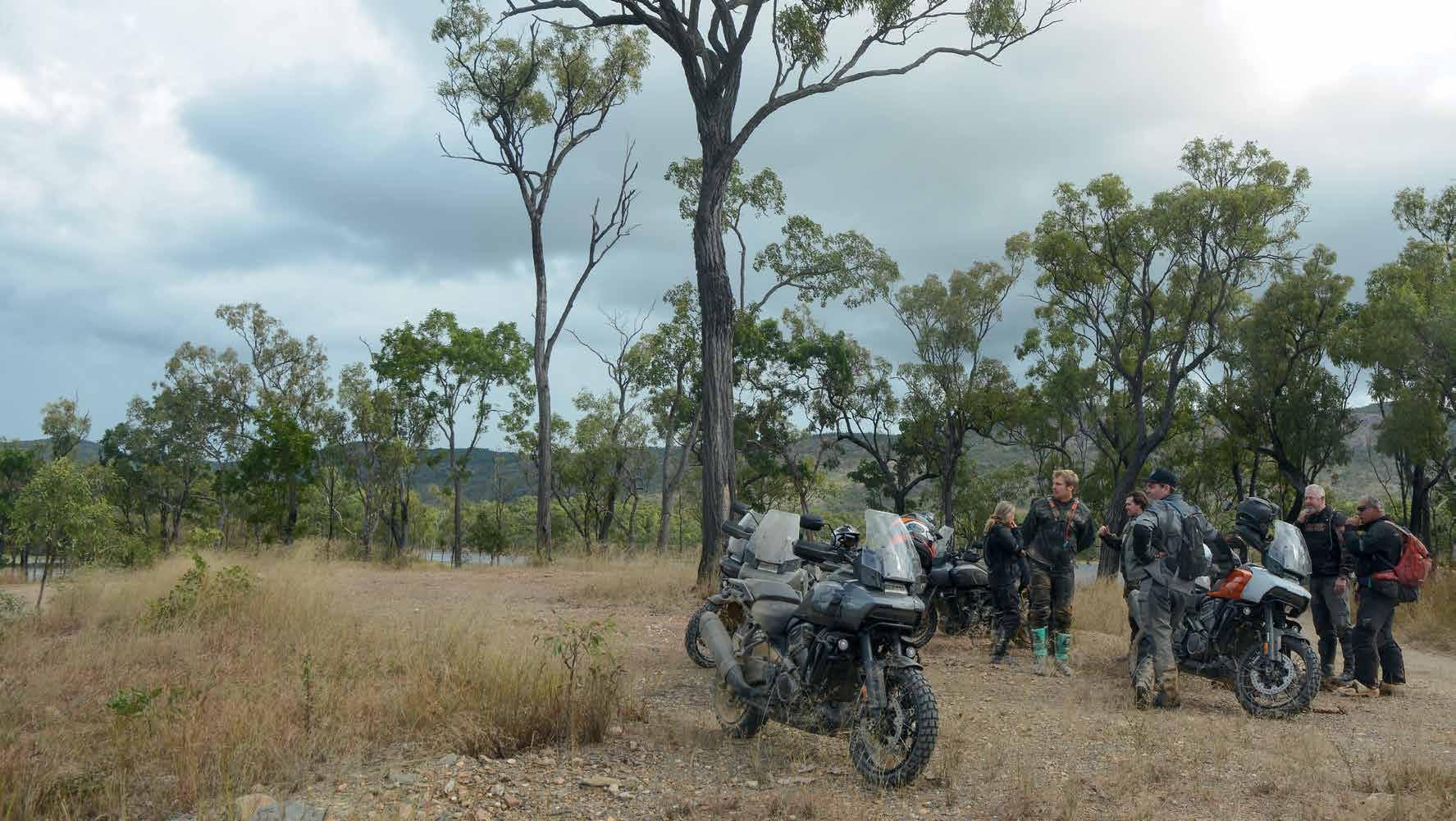



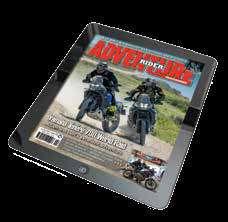
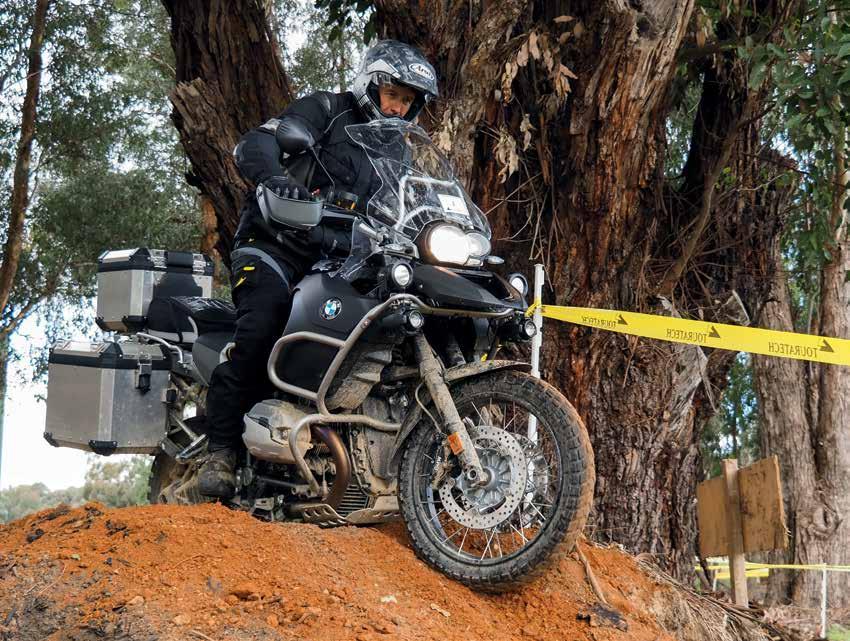

the knowledgeable and friendly team at Touratech matched the setting with impressive product knowledge and informative talks on adventure preparedness and first aid. It was a perfect scenario for experienced riders wanting to learn a trick or two, or new adventure riders who needed a base of information for their new craft.
The support from the Touratech staff and their willingness to share information was, as always, second to none.
A major drawcard for many were the manufacturer test rides.
In a new location, with new bikes ready and waiting to be ridden, the Touratech Adventure Day was a great reminder of why we all love riding, sharing clear mountain air and burning through kilometres surrounded by great people.
Late May saw the Touratech Adventure Day dust off its riding gear, pull on its helmet and blast full throttle back onto the calendar. It was the incentive for many to get back on their bikes after a COVID19-forced break from riding.
The new setting for the event was the idyllic location of Carboor in Victoria, about 200km northeast of Melbourne. Overlooked by many who swish past its turn off as they head up the Snow Road, the small farming town had a lot to offer adventure riders.
Shrouded by a heavy fog on the first morning, Carboor unveiled its stunning scenery as the sun warmed the adventure-riders’
Above: The adventure course was a well-crafted set of challenges which tested everyone from seasoned riders to newcomers.
Top right: Support from the Touratech team was second to none.
Bottom right: A few were surprised to see Harley-Davidson’s involvement in the adventure-riding scene.
paradise. Winding tar roads hugged by green rolling hills led the way to Touratech HQ, tucked unassumingly into its surroundings.
The Touratech store itself is a bit of a veiled mystery from the outside, but inside is a well-stocked Touratech retail shop with everything needed for any riding adventure.
The new location for the Touratech Adventure Day was admittedly a bit of a trial run, but after praise from attendees and manufacturers everyone can gear up in full expectation of the next Touratech Adventure Day at the same venue. Although the location was spectacular,
A row of tried and trusted brands included Yamaha, CF Moto, Honda, KTM, Harley-Davidson, Husqvarna, and Sherco.
The number of marques offering rides at the Touratech Adventure Day was a surprise for many, and seeing HarleyDavidson was a very pleasant eye-opener for those who hadn’t previously associated the American brand with adventure riding.
The sheer variety of makes and bikes meant all adventure-bike itches could be well and truly scratched. The takeaway for many attendees was the manufacturers’ test rides which offered an experience and convenience which simply couldn’t be found anywhere else. With zero sales pressure, riders were encouraged by the brands to spend the day hopping on and off every bike from every brand to compare their options.
The setting enriched the test-ride experience, offering winding tar roads, formed gravel lanes, and more technical off-road
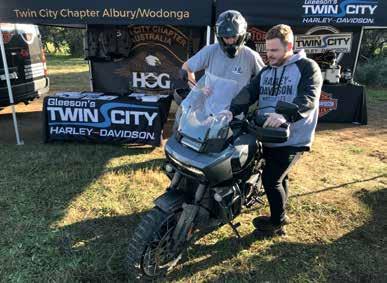

tracks. The variety of terrain let the strength of each bike shine through. There were some unexpected discoveries in the low-pressure, ‘no sales’ atmosphere of comparison.
“Someone talked me into jumping on a Honda Africa Twin with DCT,” said grinning attendee Travis. “Before today I would never have bothered to book a test ride, let alone gotten on one, but as a result of the rides I now wouldn’t buy a bike that didn’t have DCT.”
The manufacturers saw the incredible value this event offered riders and are well and truly onboard for the next Touratech Adventure Day.
Smack-bang in the middle of all the fun was the adventure course, a wellcrafted set of obstacles and challenges to test everyone from seasoned riders to newcomers.
A real treat of the weekend was seeing expert enduro rider
Mitch Harper take hold of the Harley-Davidson Pan America 1250. After a brief 50-metre blast to get a handle on the big twin, Mitch – as one spectator
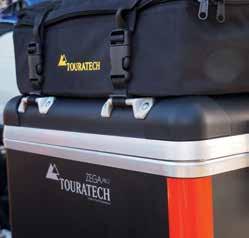
Above:
Right: A row of tried and trusted brands included Yamaha, CF Moto, Honda, KTM, HarleyDavidson, Husqvarna, and Sherco.
Below: That’s a serious trophy!
Below right: Great for experienced riders or newbies wanting to learn.
so brilliantly put it –had the bike ‘dancing’. It was an exciting spectacle and was not only a testament to his skill, but also the bike’s capabilities.
A really special part of the multiday event was the opportunity for each rider to make it their own. For some that meant journeying to the event all the way from Queensland over five days, and for others it meant taking advantage of the camping facilities and staying for the
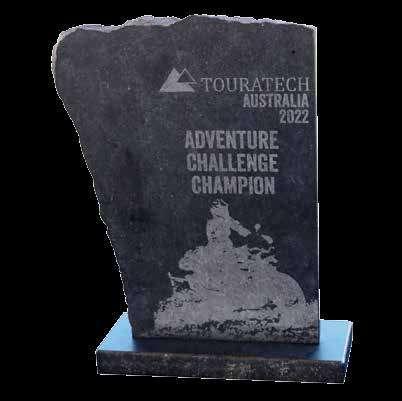

created a camaraderie that often only made sense to those who’ve attended similar gatherings. When it came to the food, the compliments spoke for themselves. A great variety of quality food was delivered by a friendly team, complete with top-tier coffee that made it hard to believe the nearest cafeteria was at least 20 minutes away.
The Touratech Adventure Day left everyone wanting more.
The good news is the confirmation of the 2023 Adventure Day being scheduled for April 22 and 23, again be staged in the heart of Carboor.
The warmth of the
These mighty events presented by the Touratech team are apparently only just getting started.

Marty HC stared down a tough weekend ride.
Words and images: Marty ‘Hardcore’ Blake
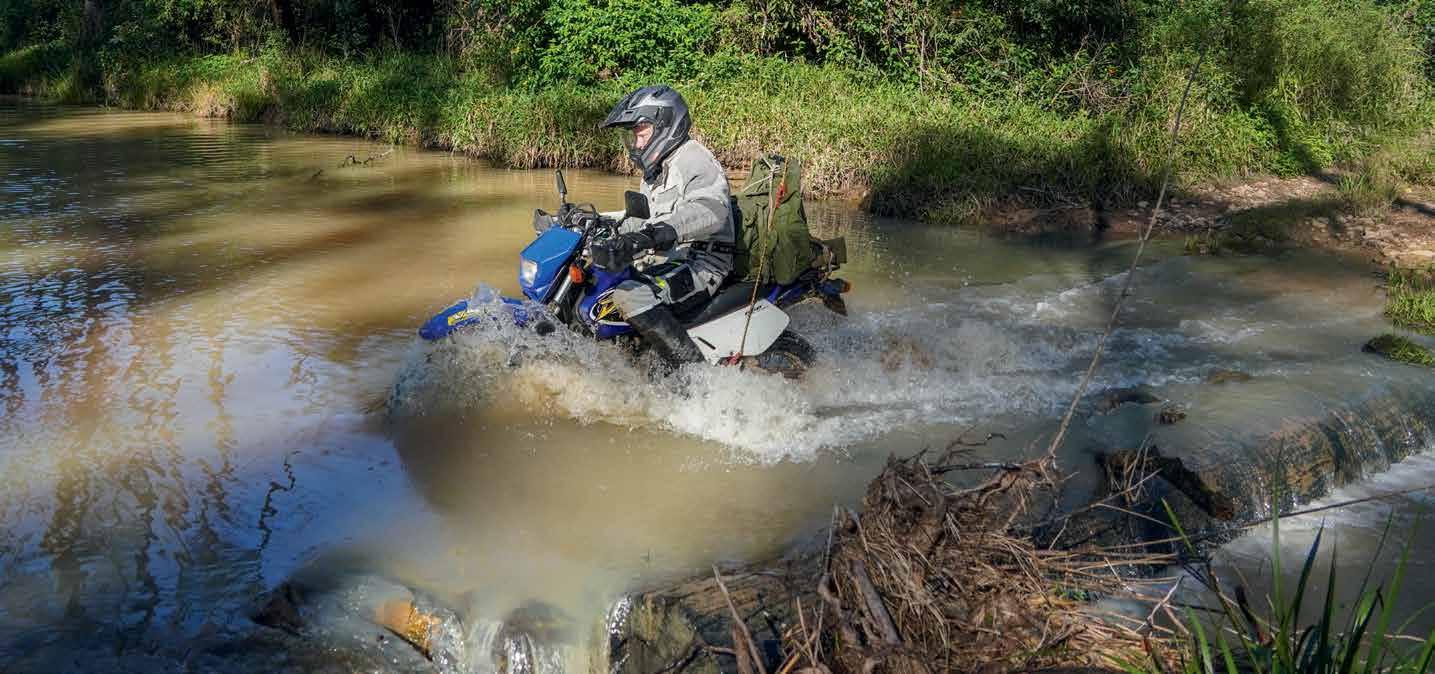
The road was a mess. Fourwheel-drives had shredded the surface into a maze of criss-crossing, slimy, deep ruts and only a skinny bank on the high side offered hope before tackling the remaining ruts at a right angle.
The more I looked at it the more it looked like a shithole. In the first section of the first day it raised the possibility of more to come.
No wonder nobody wanted to join this ride.
The run to Tenterfield was originally to coincide with the Tenterfield hard enduro, but the event was cancelled due to flooding. It rained the following weekend, and as possible postponement dates were thrown around and the rain continued, potential starters
started dropping like flies.
All except for mineral and mining enthusiast ‘Colonel’ S Lowe were suspiciously busy.
The name ‘S Lowe’ was destined for the nickname ‘Slowie’, or, sometimes, thanks to his military service
‘The Colonel’. He was a rugged individual who’d been responsible for my first adventure ride way back when, a monster of a challenge that included seat-deep creek crossings in the dark and a trackless cross-country section joining two roads.
After that experience I was hooked on the coffee-free adventure stuff, and for this ride it was just the two of us again.
With a dawn start scheduled at the nearby village of Coramba in northern NSW, I rode off into

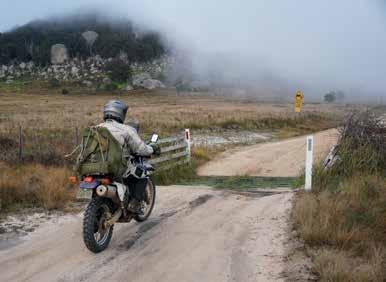
the dark, and after a quick refuel, turned up only a couple of minutes late to find Slowie adjusting his army-issue backpack and keen to go.
A quick blast up the mountain bitumen launched us on to what started as firm, fast, dirt roads, but the good conditions soon disappeared and became the muddy maze described earlier. The execution of my attack on the section wasn’t quite as graceful as I’d imagined, and I sort of fell off the bank and bounced across the ruts with legs flailing. Still, I ended up on the other side, and I was happy with that.
I straight away continued on so The Colonel would have to follow. Putrid bogholes appeared frequently and kept us on our toes, and after another 40km or so we hit the start of what turned
out to be 30km of rutted slop. The soil was mostly slippery and soggy, but every now and then became surprisingly grippy and wrenched the front wheel over for an unexpected rapid change of direction.
Staying upright became a huge challenge, but every time I tried to take a photo Slowie was right on me before I could get the camera out. He wore a steely expression that clearly indicated he had no intention of doing photo stops.
Eventually we crawled out of the muck, carrying a good proportion of it with us, and motored into Jackadgery for second breakfast.
The run up through Hanging Rock was glorious; firm, white granite meandered through rich green paddocks and followed the mighty Mann River.
The first bridge crossing brought the heart rate up slightly with the raging water just lapping, or just spilling over, the
edges of the low timber span. Unsure of how deep it was at the far end I gingerly edged my way across before pulling out the camera for Slowie’s traverse.
The next few bridges were the same, except one was missing planks and the other was sprinkled with debris and had water exploding up through the cracks like an overactive geyser.
Once across the bridges some sections of road were missing, and the remaining surface was freshly laid river rock or deep ruts and huge washouts.
We made quick work of the sprint to Drake, and a fast refuel and snack at Tabulam had us right on time.
The run through Sandy Hill was bliss.
Twin track wound through rolling green farmland and across the Boonoo Boonoo River where we stopped at the small falls.
I clambered over boulders downstream to grab some photos while the Colonel
admired a selection of unusual rocks –something he was inclined to do from time to time.
Dark clouds had started to form and a few drops of rain fell as we checked out the WW2 tank traps. Slowie disappeared into the scrub mumbling something about ambush points and machine gun posts, and I eventually lured him out with tales of Thunderbolt’s hideout. It was a fair walk from the signpost to the hideout and it was getting late, so we decided to skip the walk. We had an uneasy feeling we were being watched. There’s no such thing as bushrangers anymore, but the feeling persisted and the scrub looked eerie in the low light.
I dragged Slowie away from sifting through some gravel and we bolted for town.
We arrived at Tenterfield at 4.30pm, right on time (I love that), gathered some drinks and found a bunk for the night with our bikes tucked away safely. You can’t be too careful with DR650s in short supply and secondhand examples going for a king’s ransom these days.
A slap-up feed mixed with tales of past rides over a few choice beverages passed the night nicely.
Sunday dawned cool with a few threatening, black, low-hanging clouds, and as we loaded the bikes I noticed a section of the GPS route was missing.
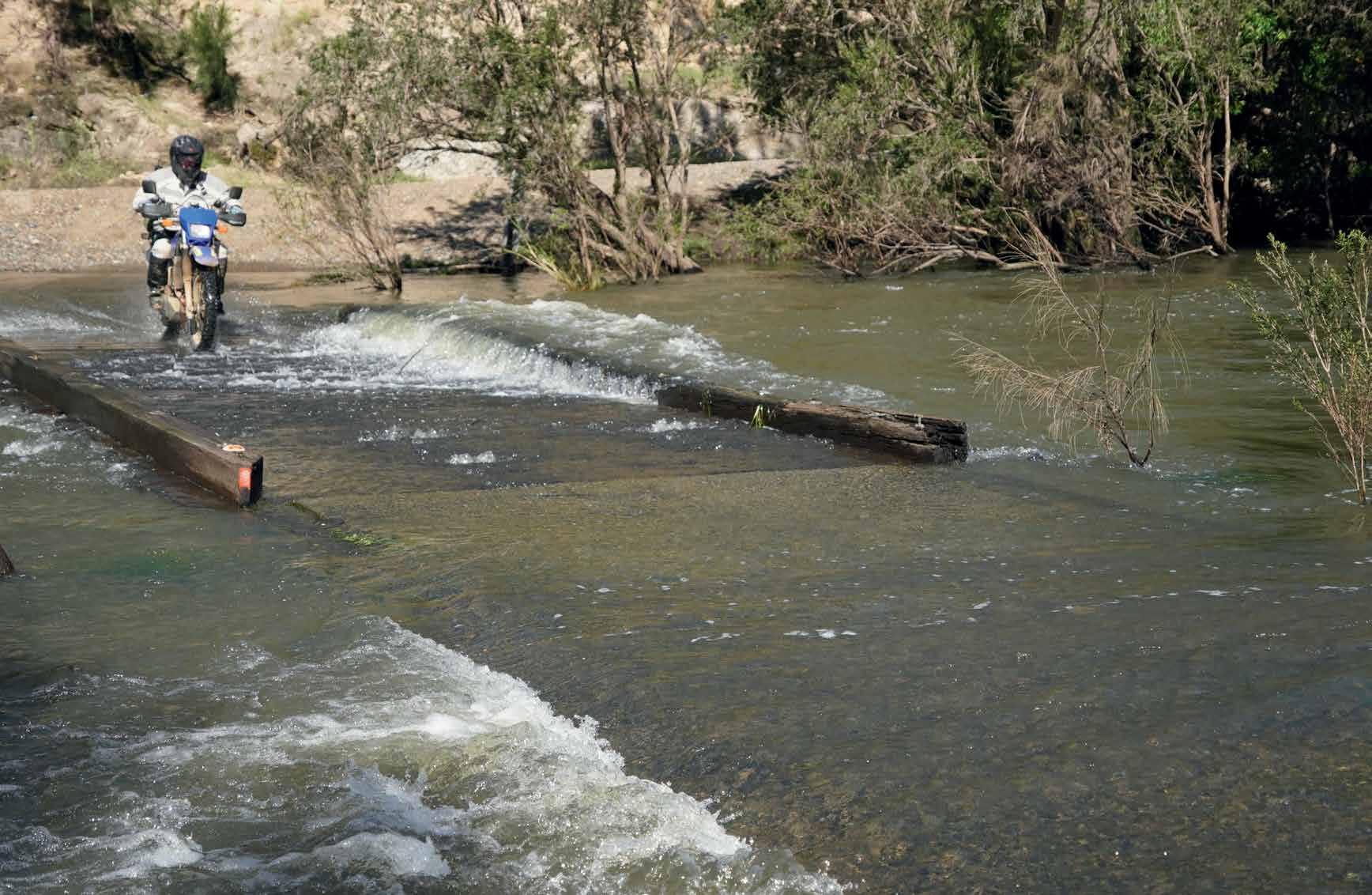

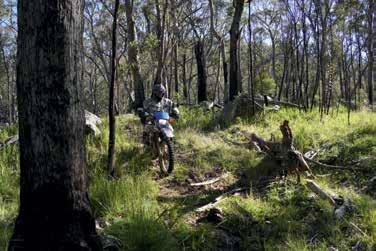

Fifteen minutes later, thanks to Google Maps, I had an old-school route sheet scrawled on a scrap of paper. We skipped breakfast and a refuel and bolted.
Coolman
It was a cold morning and the ’roos were jumping – I guessed they were trying to keep warm. A light mist at the start meant visibility was at a minimum, and after a few kilometres we plunged into a thick, murky fog that really had us guessing at the location of the furry speedbumps. Eventually we dropped down the hillside, the fog cleared, and we were cruising alongside Pyes Creek Road. A stop at one of the many causeways saw Slowie collecting rocks and stuffing them in his bulging backpack.
We cracked the throttles open, spurred on by big slide tracks on the trail surface, thankful the marks were from the previous day. By the look of the tracks nobody had been too concerned about keeping left on blind corners.
The closer we got to Emmaville the better the country looked.
Hungry
I rolled into Emmaville and waited.
Slowie was MIA. Unsure if he’d found another pile of rocks to play in, I carefully backtracked, only to find him about three kilometres out of town with his tank bone dry. We drained a litre or so out of my bike and I was shocked at how little fuel I had left. Sand sure makes the bikes thirsty. Slowie had started to complain about missing breakfast, so we bolted to Glen Innes and arrived

bikes straight and under control.
Thankfully we were near the bottom when my rear brake called, ‘Time out!’ and after a couple of near tucks on the front end we were back on formed roads.
just as the town clock rang out at noon.
A warm shop and a quick pizza wasn’t quite the counter lunch Slowie had wanted, but it warmed our cockles and filled our stomachs.
The day was still crisp as we headed across the range through more green farms, and the road became narrow and rocky, slowing the pace considerably.
Before long the sawn logs beside the road disappeared and were replaced with dark, damp forest. Bright-green moss shone in the dappled light and filled in the gaps between the clumpy grass and the abundant rocks.
The trail all but disappeared and we had to clear, smash and jump our way along skinny ridges with huge drops to gorges below.
Eventually the remnant of a damp and slushy trail became a loose, steep, rocky downhill. The views were impressive but we could only afford quick glances as we fought to keep the
The short section had chewed up lots of time so we bolted.
It started to cool again as we climbed into the dark, old-growth forest of Chaelundi National Park, where the long shadows hid lots of potholes and embedded rocks which kept us on our toes as we slammed through. Wanting to make the most of the little remaining light, speeds were up and my wrists started to ache from slamming unseen obstacles and the cold seeping in.
Despite being in quite good nick, it wasn’t the most fun I’d ever had through there.
Darkness fell just as we burst out of the forest, and after a quick break to refuel and remove my headlight guard to improve low beam, we followed the bright, white hole my LED light bar carved into the gloomy night.
After around 870km and 21 hours saddle time we were home, completely satisfied, but rooted. It’d been hard riding in places, but we’d covered a lot of stunning countryside in a relentless push with few stops and lousy coffee.

Maybe the guys are onto my ‘Hardcore’ rides. I struggle to get starters it seems. But a text the next day from Slowie pointed out a few more Thunderbolt relics further west and suggested another two-day ride.
It gave me hope adventurous adventure riding hasn’t been lost in a sea of coffee shops.

IComfortable over long distances on the road, but still at home hitting tough off-road trails.
t’d be fair to say we’ve given the Shop Bike a fair shellacking since the last update in issue #52.
A run with RideADV in Victoria meant a lazy 1000km blast down the bitumen from northern NSW to Jindabyne at the base of The Snowies. It belted down rain pretty much the whole way, which made that section of the ride a little less than glorious. From Jindabyne it was a four-day blast through the Victorian high country, then another 1000km back up the bitumen, and it was all accomplished with ease. The Ténéré 700 is clearly a superb dualsporter. As we’ve said previously, the motor is smooth, torquey and incredibly easy to use, the ergos are probably within cooee of where they need to be for a high percentage of Aussies, and it’s very capable off-road, as we discovered on some wet, slimy tracks, a few rocky climbs, and a handful of high-speed dirt roads. The bike is a winner, no doubt about it.
But there’s always room for improvement, and we made a few gains with good equipment over the past couple of months.
Radiators have always been a bit of worry for off-road bikes. They’re potentially vulnerable and difficult to bodgy up if the core is punctured or damaged. The best bet is to try and prevent the damage in the first place, and the folks at Rad Guard are the
experts in radiator protection. Paul at Rad Guard and his capable staff grabbed the Ténéré, whipped off the standard plastic cover and fitted a swish-o, aircraft-grade aluminium guard that looked droolingly brilliant and as tough as Julia Gillard. We hadn’t heard of any radiator problems on the Yamaha, and as far as we know it’s not prone to damage, but protecting it seemed like common sense. We’re running Rad Guard gear on several bikes, and its beautiful fit and finish is an added asset over its protective function.
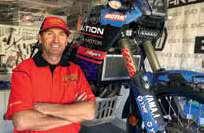

Above: Paul from Rad Guard spends a bit of time fitting Rad Guards to our bikes.
Above insert: The beautiful fit and finish is an added asset over its protective function.
Below: Motoz supplied a RallZ 90/90-21 for the front and an Adventure 140/80-18 for the rear. The improvement in the bike’s handling and stability was astonishing.
We mentioned after our early rides, the front end of the bike felt a little strange and didn’t inspire a great amount of confidence. The bike had been dropped before we took delivery and we were a little concerned forks or frame might’ve
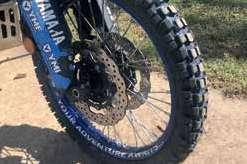
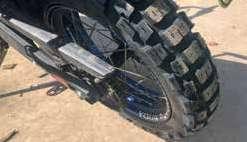
been tweaked out of line.
But it’s always good to rule out the simple things first, and the front tyre was a full enduro knobby, which, in our opinion, didn’t belong on a bike of this size.
Sure enough, the folks at JTR set us up with a pair of Motoz Tractionators – a RallZ 90/90-21 on the front and an Adventure 140/80-18 on the rear – and the bike was transformed. In fact, we’re a little embarrassed to admit we put up with it in the first place. Now we’ve been able to make the comparison, the handling and stability of the bike with the enduro-style knobby was bloody awful by comparison.
The Tractionators not only handle the bike’s size and weight well, they give the rider plenty of confidence on and off road, even in the wet. Wet bitumen substantially reduces feel to the rider, but no more than most other dirt-pattern tyres we’ve tried, and in wet offroad going, both rock and mud, they performed really well.
At this stage they look to be quite durable, too. After all the bitumen and off-road flogging, both front and rear still look in good nick.
We have a sneaking suspicion the Ténéré 700 might be kind to tyres, but we don’t have any credible measurement or testing to say so. It’s just a feeling we have about the way the power’s
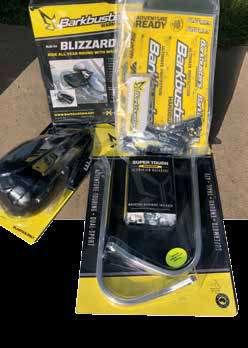
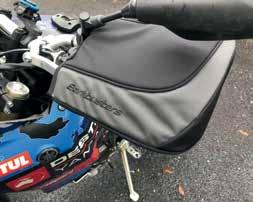
delivered and what we’re seeing.
In any case, the Tractionators are doing the bizzo, no question, and are clearly well suited to the bike.
Barkbusters are one of our favourite products ever.
The editor gets all misty-eyed when he starts blubbering about racing last century, and how Ted Goddard – the Australian engineer and patriarch of the well-known and highly successful racing family – used to bend guards by hand for the Australian enduro community.
Things have moved on quite a lot since then, and there’s now some very impressive automated robotic manufacturing processes, and Barkbusters supplies OEM product to a wide range of manufacturers around the world.
But riders’ attitudes to Barkbusters haven’t changed: they’re still considered essential equipment for anyone heading off road.
The handguards fitted to the Shop Bike weren’t too bad, and of course they’d been included in the super-schmick 3M decal job. But they were plastic guards which didn’t have the rock-solid protection of aluminium or alloy backbones. The inner mount, for instance, was a thin metal strip held in place by the mirror. They were quite good for keeping windblast off the knuckles, but not for impact protection.
That’s where Barkbusters are the real deal. They’re tough kit designed to protect hands and levers at race pace in the Aussie bush, and they can cop a flogging.
The aluminium backbones can take a variety of plastic covers with names like Sabre, Jet, Ego and so forth, and because we really like our hands to be protected from wind and rain, we opted for Storm
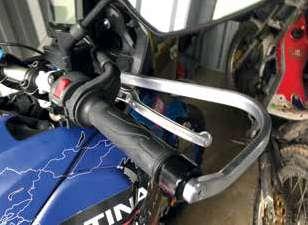
guards. They look a little oldfashioned compared to some of the more race-focussed ones perhaps, but the protection from the elements is good.
But the folks at Barkbusters also sent us a pair of Blizzards, and with the rain smashing down on NSW and temperatures plummeting, Blizzards are the mozzie’s cozzies. Protection from the weather and cold wind is really top shelf, and they slip on over the top of the aluminium backbone in a minute or so.
We reckon they’re awesome, and
Below left 1: Barkbusters aluminium backbones, mounting kit, Storm guards and a pair of Blizzards. Blue-ribbon hand and lever protection. Below left 2: With the rain smashing down on NSW, and the temperatures plummeting, Blizzards are the mozzie’s cozzies. Below left 3: Tough kit designed for protection at race pace in the Aussie bush.

we’ll be running them for at least the rest of winter. When things warm up a little we’ll swap to the Storms, but we won’t be in a hurry.
The Ténéré 700 is a first-class dualsporter. There’s no doubt about that. How little we’re changing the bike itself shows how good it was to start with.
Right now we reckon it’s ready to tackle just about anything, but half the fun of owning a great bike is personalising it, so we’ll keep chipping away at bits and pieces here and there.
We’re not sure where we’ll head next. Probably luggage. We fitted a Nelson-Rigg heat shield on the exhaust side to be ready for a set of soft panniers, and we’re thinking that’s the way we’ll go.
We’ll let you know.
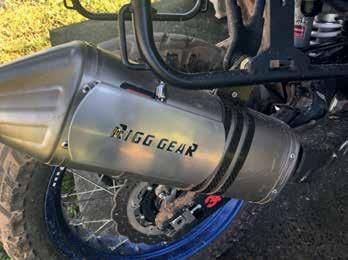

Like you, good reader, I don’t mind sitting up late on a Sunday night with a blanket across my lap, in a quiet house with a block of chocolate, absorbing an international road race on the telly. I reckon it’s one of the last great gladiatorial sports. MotoGP riders banging fairings, dragging elbows on the track and braking so hard their cojones must end up in their throat seems to defy physics.
Exiting a corner under power in a set of mountain S bends with the front wheel light and changing direction with the footpegs is one of the ‘Fk yeah! How good is this!’ moments a motorcycle can provide.
Riding a rural road like it was the Mugello track is obviously a life-limiting exercise, but I’ve seen it done in many a ‘ya gotta be off your gourd’ fashion.
One of the joys of the motorcycle is us riders are keen to build on our skill set. Riding smoother, faster and safer permeates our lifestyle.
Over the years I’ve sort of made my own study of what I’ve come to call The Rural Line – working on the theory of ‘when you least expect it, expect it’ combined with the ‘can’t see, can’t go’ maxim. I set up a somewhat different line to the ones we see the warriors take on the telly.
The aim is to be in a position to nod to myself and say, “Yep, he was just where he was expected,”
at the next curve where the farmer’s 4X4 ute has the rear corner of the tray hanging over the double white lines.
Been there done that with riding buddy Tomaselli. We both made a small adjustment to avoid the situation and it was like biker ballet as we adjusted our line. Our next stop was a joyous, “How cool was that!” rather than a skiddy hose out.
The whole idea is to get a good look through the corner before committing and tipping in. The Rural Line had all the same hallmarks as the racetrack: concepts like road position, brake-throttle overlap, picking entry and exit points…but the environments couldn’t be further apart.
My Rural Line is slightly J-shaped, leaving entry a little later than a race-line, allowing me to tip in with more of a gap to the centre line and a wider view of my exit. Entering a corner from the lefthand wheel track or even closer to the left of the road increases my, or, more correctly, the oncoming road user’s, margin for error. It also helps me reduce the chances of running wide as well as providing more choices if I need them.
As Tomaselli says: “Physics are only a guide” So too are centre lines. They are arbitrary containment marks to corral distracted car drivers. Yeah, sure, the coppers tend to get their pens out if we cross two of them but, as my Mum
up’, but road vision is a little more targeted. Road riding requires us to set up the position in the lane, have the braking sorted and be in the right place to tip into the corner, pick that tip-in point, then set our focus immediately on the exit point, momentarily choosing a specific point in the road our front wheel proceeds over.

frequently remember Wayne Gardner’s line: ‘slow in, fast out’. The better I can see through the corner, the easier it is to accomplish this safely.
used to declare, “It’s only illegal if you get caught”. I reckon it can be safer to risk a fine than not see what’s coming the other way. Slow down? Are you mad? Where’s the fun in that?
Using the same line a racer might through a set of S bends or a nice left-hander sets up an exit that little bit to the left of the centre lines. It’s quicker, smoother and safer…honest, your honour! Setting up for a left-hander has me very near, or to the right of the centre line, playing eye-spy with log trucks before commit. Sure, the lane-marking lines can be slippery, but I’m set up in such a way as to cross them pretty much upright. And it’s not wet-weather hijinks anyway. That’s a whole other skill set.
Naturally, the variants of a green, slimy patch, diesel, a branch on the road and gravel spills can pop up at any moment. And, as with all adventure riding, there’s a compromise to make. To my mind, not only is it the safest, it’s also where the ‘Phwoar!’ is. I can get on the throttle earlier, drive out and set up for the next corner earlier. Like all motor-bicycling, you go where you look. I find there are subtleties specific to the blacktop. On the road we tend to need to look for our entry and exit points. On the dirt it’s more of a scan of the upcoming track and planning the line through the ruts and rumbles. Both need us to ride ‘head
Adventure bikes are not all creek crossings and white-knuckle descents. Tackling a glorious mountain road on the black stuff is closer to my comfort zone. I fall off less and need to hose less crap off the bike…not to mention my undies.
Long live dualsport!
This system works for me after 45 years of study and practice. It’s not gospel. It’s what find helps me. Each person should ride to the conditions and their level of skill. Strapz

Setting up for a left-hander using The Rural (red) Line has the bike very near, or to the right of, the centre line.
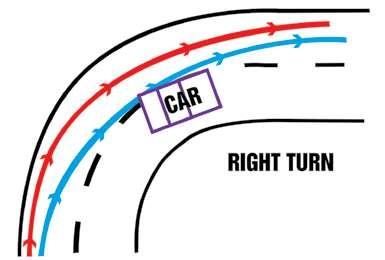
A right hander using the Rural (red) Line is slightly J-shaped, allowing more of a gap to the centre line and a wider view of the exit, providing more choices if needed.
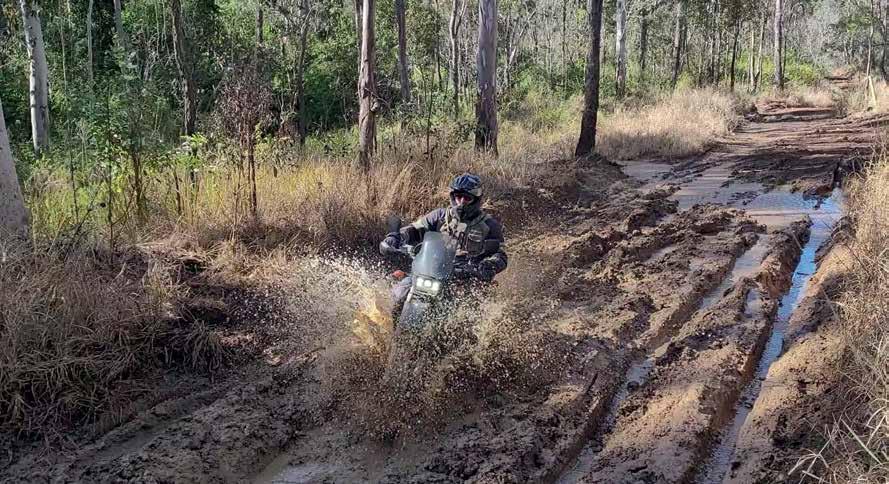
I‘m not sure if it’s since COVID and all the lockdowns and I’ve just had more time to notice, but there seems to be an ever-expanding number of adventure-bike tour groups around.
Although I like to think Dave and I just ‘wing it’ and go where the roads take us, the truth is, most of the time that involves Dave doing a whole lot of map reading, online research and talking to people to find the best hidden tracks and places to see. There was an instance where we’d get to a road
junction and toss an imaginary coin to decide the direction we would take. This might occasionally lead to some hidden gem, but, more than likely, it’ll need a bit of preplanning to get the best from a ride. If you don’t have time to plan it all yourself, there’s plenty of options, both paid and social, to try.
With that in mind, when I saw there was a women-only ride close to home and in an area I was pretty unfamiliar with, I signed up.
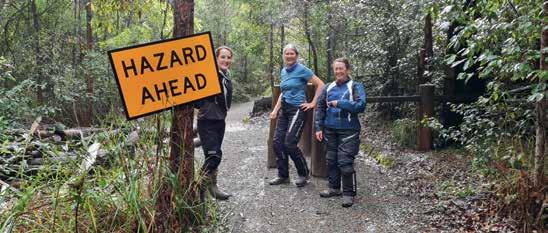

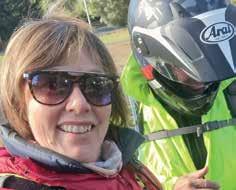
I know I’ve talked about this previously, and before any blokes start saying it’s discriminatory, sometimes women like to have the opportunity to talk freely and discuss periods, bra fitting and thrush, along with tyre pressures and bike mods.
The irony of having men running women-only rides is not lost on me – which is where it’s great to see people like Elsewhere on Wheels and Ellwood Motorcycle Tours, with women at the helm. If having women leading a ride can give more people the confidence to get out on a bike, it’s a win. There’s also the fact it seems easier to ask other women riders questions about your bike or riding and get easy-to-understand answers. Plus,
it’s the opportunity to meet other women riders in person, not just chat online. did a couple of RideADV women’s rides a few years ago, and I was really impressed by the fact they walked the talk. They’d said, like many other rides I’ve been on, “We’re travelling through farming country so be respectful – like slowing down to not cause too much dust when passing a house.”
was happily riding along at the back of the pack when I caught up to the main group positively crawling past a property.
‘A bit of overkill,’ I thought. I looked ahead and there were some mares and young foals in the paddock beside the road, and
the lead riders were making sure everyone went past at a walking pace. That earned a big wave of thanks from the farmer, and an increase in respect from us riders.
Kye high
Back to the women’s ride. It was run by a new operator, Kye Anderson of Endeavour Motorcycle Tours. There’s a feeling of trepidation I get when riding with people I haven’t met before – will I hold everyone up? Will I stay upright? How long before I say anything to embarrass myself? Due to illness and other issues, there were only three starters on this ride. Any
nerves I was feeling about my ability were doubled when I found out one of the other riders, Donna, riding a WR250F, had been a roadbike rider when one day she decided she’d like to cross the Simpson – which she did successfully! I’d already sussed out that Kye had ridden in some serious events like Romaniacs and at Erzberg, so I began to think this ride was going to be way above my skill level. Fortunately, sand skills weren’t called on until the second day, and at any tricky bits Kye was standing by to direct riders on how to tackle it if needed. Apart from some lovely tracks, his passion for the natural and historical environment was what really stood out about the ride. He’d ridden, hiked or kayaked over most of the area and had a great knowledge of the Aboriginal and European history. It was a tour of the local area by motorbike with some stunning scenery, great stories and interesting tracks to tie it all together. They’d gone about things the right way: getting permits to operate in National Parks and state forests, decent food and a good overview of where the toilet and
u



fuel stops would be during the day. There’s a few kinks to iron out, but Endeavour Motorcycle Tours is on the right track.
The latest group ride I went on took place out the back of Toowoomba, Queensland, on a freezing cold weekend. It was the famed and exclusive Take A Peek @ Emu Creek ride, organised by the local Emu Creek Hall committee. It was their fourth ride, capped it at 75 riders to allow for
camping space and catering. Otherwise they’d have hundreds there.
Having had to call it off due to drought and lockdowns in the past, this one needed a fair bit of modifying due to rain. Goof, Duck and the other dedicated blokes gave up countless weekends to put together the best tracks for the crowd. How does this ‘tour’ differ? Well, there’s the feel-good factor knowing you’re helping a little community hall. They split the group into three: Fast (orange egos), Steady and Tourists. You just put your name down in whatever group you want to ride in. Everyone does the same tracks, just at a different pace (although, funnily enough, the Tourist group managed to catch up with the other groups on more than one occasion). Toby Price makes an
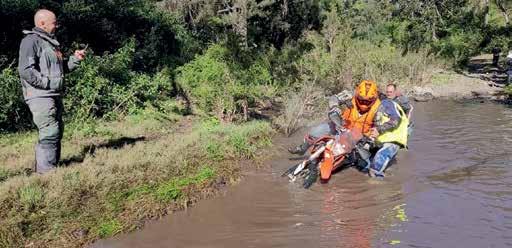
appearance each year (in name only) on the board. This has become a standing joke after the first year when Jodie was doing the registrations and couldn’t find the paperwork for ‘this Toby Price bloke’. The rides have a lead and sweep, plus a few guys riding in the group keeping an eye on everyone. It was interesting to hear one of the riders, Jenny O’Driscoll (who can now proudly call herself a ‘Peeker’), on her first cornerman-type ride. She was really impressed by the organisation and the camaraderie.
“When we came to the more technical sections, like the deep, muddy bog, everyone pitched in until we were all through,” said Jenny. “In such a big group, it puts you more at ease knowing there’s others who can help if you’re struggling.”
Another reason this ride is so popular is probably something to do with that intangible – country hospitality. They’re not out to make a fortune, but, if they can put a bit back into their hall and show everyone around their backyard, everyone’s a winner.
What i’ve learned
R Southeast Queensland frosts are savage
R Don’t get drunk on cold nights because you won’t want to get up through the night
R Look ahead and not where the person with the camera is looking
R There should be more conversations about periods and prostates
R Emu Creek cooks make a pretty mean slice
Think, and protect our sport.
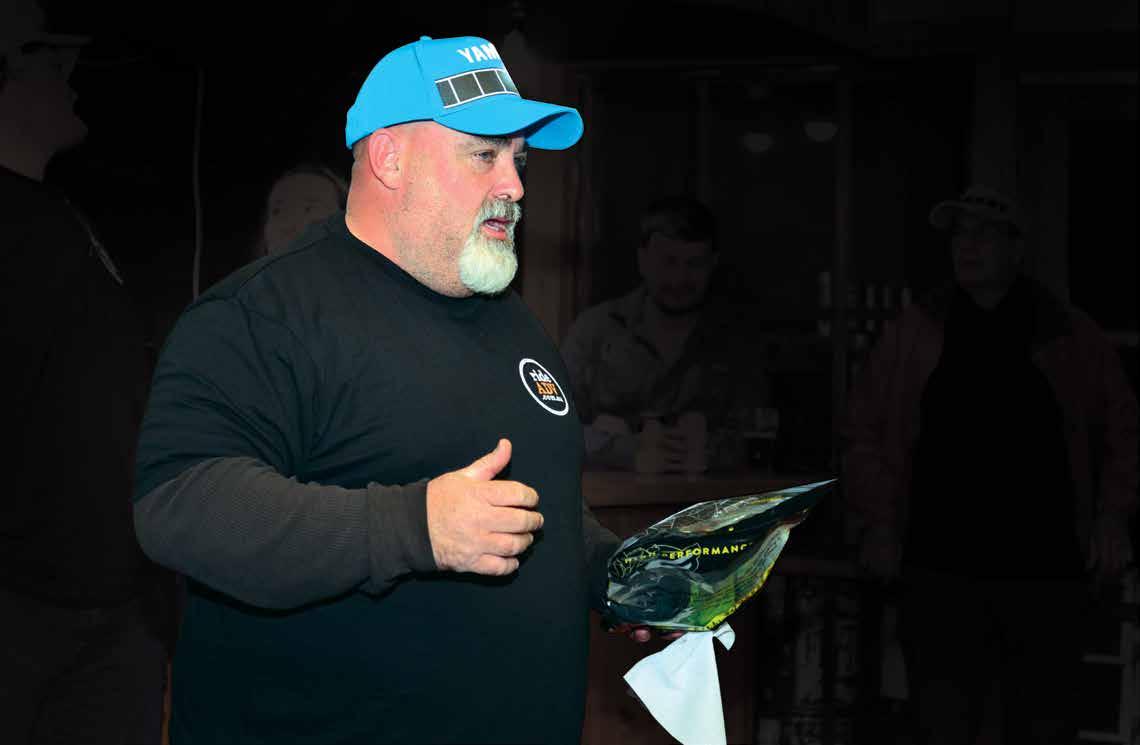
t’s time to take some responsibility. What we do on our own or as a group represents our sport. All of us on two wheels – enduro, adventure, café racer, big-bore tourer or whatever – are all seen as one group: motorbike riders.
The environment has changed. With the explosion in popularity of dash cams and mobile phones with cameras, together with the emergence and popularity of social media, things have changed
forever. We are all the front line, and the last line, that represents our sport. Everything we do – in the remote outback, on country roads, in the bush, in the backblocks of our states or on the busy city streets trying to escape – we are always on display, and it’s up to us how we are perceived.
I make it a rule on all RideADV rides that all RideADV crew wave to everyone they see: farmers, people sitting on their verandas,
cars coming the other way, even pushbike riders. It’s also a policy to always check on people who may need a hand.
Perception is reality in the minds of the public. We need to crush and eliminate the old mindset that all motorbike riders are selfish, ignorant, tear-arse, antisocial, environmental vandals, and we can start by looking ahead. We can currently see pressure being applied to lock us out of riding areas we enjoy. It’s been going on for decades and it’s easy. A
stay on the throttle? It’s not a race.
We damage our reputation further when riders insist on arguing with a farmer or property owner about whether a track is a public or a private road, or if it’s gazetted or not.
I’d say 99 per cent of the time there’s no point arguing it there and then, because you don’t really know the situation. We need to remember some roads are private property, and that’s all there is to it. The farmer may have bought the land and it’s no longer a gazetted road. It may never have been, irrespective of what the keyboard warrior said on Facebook. I see people write, ‘Oh, you’re okay to use that road, that farmer can’t do that.’ Then people start saying, ‘Just cut fence down’. ‘Go around the gate’. ‘Take bolt cutters’.
Seriously!
I cringe. This is exactly the behavior and thinking we need to stop.
I run a tour company and do about 80,000km each year prerunning or running rides. On every prerun I deal with road closures, farmers, rangers and the public. We need to remember there are most definitely roads bounded by private property on either side. We can use those roads legally. But imagine being that farmer having to listen to his wife upset that every weekend she puts washing on the line a bunch of bikes tear past and cover it all in dust. Nothing is gained by having a yelling match with a farmer.
Sure, there are times when someone tries to pull the wool over your eyes.
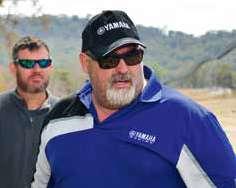
stroke of a pen from a government official somewhere and its done.
We need to become more considerate to the general public. They’re the ones putting pressure on the politicians to change things, and they’re the ones we need to co-exist with. If we don’t cause an itch it won’t have to be scratched.
And like a problem with a bike that won’t start, we should do the simplest things first, like rolling off the throttle when we pass bushwalkers, mountainbike riders, a house, a farm, or livestock. Seriously, where are we going in such a hurry on a 300km day that we have to
On a recent prerun I had a farmer ride across a paddock waving his arms. I stopped and took off my helmet (I reckon it’s always important to take your helmet off so they can see you). He said, “You can’t go up here.”
“Oh. Okay,” replied. “Are you saying this is a private road?”
“Yeah,” he asserted. “This is my driveway.” I politely asked him how much he’d paid for the white posts with reflectors that lined the road, and why there were so many mailboxes along his driveway.
He ’fessed up it wasn’t his driveway, it was a public road. He was upset a tour company had gone through the previous year and there had been an incident with
some spooked horses. One had gone through a fence and no one slowed down. Ever since that event there had been multiple bikes up there every weekend, and some were leaving the road to ride the paddocks and the hills, tearing up grass and causing soil erosion. I listened to him and I got it. I understood.
I explained we would be going through with a group, that we would put out a ‘slow zone’ flag, and we would collect that flag at the end of the day. I also explained I expected our people would do the right thing.
Now, I’m no saint, but I’m getting older and wiser. I find myself playing through scenarios in my head where I see things from others’ point of view and they guide me to decisions that help all of us. Give it a try.
Finally, as a sport, we need to make sure we leave nothing behind. Not old tubes, wrappers, direction arrows, stickers…we can’t leave any sort of rubbish. If you see something that shouldn’t be there, even if you didn’t leave it in the first place, pick it up. It reflects on all of us. We need to take immediate action to hopefully encourage other groups which use the areas we treasure to do the right thing, too. The irresponsible element is ruining it for all users of the bush, whether they’re fellow motos, the four-wheel-drive boghole bogans, mountainbikers, or anyone else who uses the areas and terrain we enjoy so much. This element must be influenced to change or they’ll ruin it for all of us.
If you think this isn’t important you’ve been living under a rock.
Ask around. Listen to what’s happening to our brothers and sisters in the single-trail community.
It’s incredible how smooth elite off-road riders can look as they manage their bikes on rough terrain.
Possibly the biggest single technique that allows this is the way the rider stands on the bike and uses their body to be balanced, efficient, work with the terrain and not be a passenger.
You could call it ‘stance’ or ‘posture’, and you’ve probably heard the term ‘the attack position’. This is the way you control a bike when riding off road.
The flip side is the Legoman syndrome, where riders are stiff and rigid, burning up energy, fighting the bike and generally not being able to ride with the same speed or control.
Adventure riding takes in many styles of riding on a wide range of bikes. Sometimes on the road, then gravel roads, fire trails, rutted trails and steep terrain.
You need a variety of techniques to be able to ride all of them well. It doesn’t take long for riders new to off road to realise they should stand when they hit rough dirt, but there’s standing, and then there’s standing.
Let’s start at the bottom and
work our way up.
I would say the best way for most riders is to position the arches of their feet over the footpegs, not the balls of the feet. This gives good access to the gear- and rear-brake lever, and the foot is supported well to absorb the rider’s weight and impacts on the bike. It’s really important to slide your foot in, with no gaps, so your boots are snug against the frame.
The knees should be somewhere near the tank/seat junction on most bikes.
Many riders stand from the seating position by raising their bum, leaving their knees in the same position, a bit too far forward. This leads to the classic ‘Meerkat Adv Rider’ stance.
I laughed when I found the Germans have a term for this stance that translates to ‘eggs on the tank’. Just picture it. It’s pretty
obvious what they are getting at.
To get the knee position correct imagine someone pulling the rider rearward by the back of the pants. With straighter legs in the right position, you’re better able to raise and lower your body to absorb bumps and movement of the bike. The primary grip on the bike should be with the lower legs, eliminating the need to grab on too tight with hands and arms, leaving them free to work the clutch, throttle and front brake effortlessly.
Arch your back slightly, don’t try to stand up as tall as possible. Aim for slightly soft knees, a slightly arched back and soften the arms down to the ’bars. Depending on the terrain, arms and elbows can be a bit straight for cruising, or more aggressively bent outwards for rougher terrain. Imagine the attacking stance of a pro motocrosser:
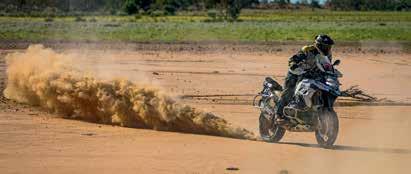
Left: Pull the handlebars towards you, slide your knees forward with straight legs, and lean into acceleration forces. Main: Arch your back slightly. Don’t try to stand up as tall as possible. Aim for slightly soft knees, a slightly arched back and soften the arms down to the ’bars.



avoid pinning your elbows to your body. Get them a bit out so you can use them more effectively as ‘suspension’.
Get into the habit of having one or two fingers – use your hand to imitate a gun –covering the clutch and front-brake levers. This only takes a short while to get used to, and once you have the habit anything else feels wrong.
The head should be somewhere over the fuel cap or handlebars, depending on your bike. Keep the chin up so you can look further ahead.
Here are a few areas where most riders can make huge improvements.
Vision: look way out in front, not at the front guard or just ahead of the front wheel. If your vision is further forward you can see what’s coming and make adjustments to speed and line selection in good time.
System check: if the bike has a
centrestand, get on the bike and work through these points like a checklist. If not, put the bike on a work stand and do the same.
Now, don’t be a Legoman!
The attack-position stance is great, but it’s nothing if you’re tight and stiff – like Legoman. You need to be loose and balanced, and use the full range of motion to stay balanced and complement the bike’s suspension to get the best results. It sounds simple, but it doesn’t come easy for many. I get riders to bounce lightly on their bikes to get a feeling for loading and unloading the suspension and tyres, and I love them to do the Funky Chicken. If you don’t feel silly when you’re doing this you probably aren’t doing it enough. If you’re just standing on the bike it’s very easy to be a Legoman.
Pull the handlebars towards you, slide your knees forward with straight legs and
Left: Imagine the attacking stance of a pro motocrosser. Avoid pinning your elbows to your body.
Below: There’s standing, and then there’s standing.
Right: Straight arms, knees slid back: the ideal aggressive-braking or descending-steepterrain position.
lean into acceleration forces, or to stay balanced when the bike angles on an uphill. See how far forward you can lean. Pivot from the footpegs, not your knees. Then do the same in the opposite direction. With straight arms and legs, slide your knees back to a wider part of the seat, as if someone was pulling you by the back of the pants. This is the ideal aggressive-braking or descendingsteep-terrain position.
The way I like to describe it is, your bike is a surfboard, you are a surfer, and the terrain is your wave. You need to stay loose and proactively work with your bike to be balanced and absorb the bumps. This is clear to see when riding in sand. A stiff rider loses balance, angles their steering and slams the ground. A loose, balanced rider will move around on the bike to make corrections before they lose control. Think of smooth, fluid movements with the main aim of staying balanced and efficient.
Simply ride along on a nice smooth road in third or fourth gear at low revs, gently rolling on the throttle and leaning into the forces. Then roll off the throttle and move back to brace yourself against the handlebars to absorb the deceleration.

The smooth, balanced and effortless movement forward and back between acceleration and deceleration can be a real breakthrough moment when a rider first feels it working smoothly and efficiently. The front-toback movement is directly linked to throttle and brake input. The forward position exiting corners will provide heaps more confidence with front-end feel and grip, and this is the key to steering with the throttle through a corner – the much talked about powerslide.
Once your stance is strong, balanced and agile, the next step is to really coordinate throttle use with how the bike’s suspension compresses. If you add precise throttle as the rear suspension is compressing, you’ll create awesome traction. If you add throttle, or simply leave the throttle open, as the suspension is rebounding (pushing the tyre into the ground less) the result will be wheelspin and directional instability. This timing is another game changer in many situations, especially on uphills.
Correct stance and body position are hugely important for off-road riding, especially when things get slick or technical. Throw in some precise throttle and clutch control and you can find traction where others simply struggle. The right tyre can be a bonus sprinkle on the top, but don’t think the ‘magic’ tyre is a substitute for these kind of skills or you’ll end up disappointed, upside-down and maybe embarrassed if you bang on about a particular tyre to your mates. The idea is to get to a level where all these things just happen without thinking. It’s commonly known as ‘in the zone’, and for most this takes quality practice and time on the bike to perfect. Everyone can get there if they put in the effort.

ROK StOppeR headlight guaRdS Premium, hand-moulded motorcycle headlight protectors.
R Designed and made in Australia
R One-year warranty
R UV, vibration and heat resistant
R 3M™ Dual Locks to allow for easy removal and cleaning
R Available for all major makes and models
Available from: Adventure Moto Web: adventuremoto.com.au
